Are you seeking one-on-one college counseling and/or essay support? Limited spots are now available. Click here to learn more.

How to Write the AP Lang Rhetorical Analysis Essay (With Example)
November 27, 2023
Feeling intimidated by the AP Lang Rhetorical Analysis Essay? We’re here to help demystify. Whether you’re cramming for the AP Lang exam right now or planning to take the test down the road, we’ve got crucial rubric information, helpful tips, and an essay example to prepare you for the big day. This post will cover 1) What is the AP Lang Rhetorical Analysis Essay? 2) AP Lang Rhetorical Analysis Rubric 3) AP Lang Rhetorical Analysis: Sample Prompt 4) AP Lang Rhetorical Analysis Essay Example 5)AP Lang Rhetorical Analysis Essay Example: Why It Works
What is the AP Lang Rhetorical Analysis Essay?
The AP Lang Rhetorical Analysis Essay is one of three essays included in the written portion of the AP English Exam. The full AP English Exam is 3 hours and 15 minutes long, with the first 60 minutes dedicated to multiple-choice questions. Once you complete the multiple-choice section, you move on to three equally weighted essays that ask you to synthesize, analyze, and interpret texts and develop well-reasoned arguments. The three essays include:
Synthesis essay: You’ll review various pieces of evidence and then write an essay that synthesizes (aka combines and interprets) the evidence and presents a clear argument. Read our write up on How to Write the AP Lang Synthesis Essay here.
Argumentative essay: You’ll take a stance on a specific topic and argue your case.
Rhetorical essay: You’ll read a provided passage, then analyze the author’s rhetorical choices and develop an argument that explains why the author made those rhetorical choices.
AP Lang Rhetorical Analysis Rubric
The AP Lang Rhetorical Analysis Essay is graded on just 3 rubric categories: Thesis, Evidence and Commentary, and Sophistication . At a glance, the rubric categories may seem vague, but AP exam graders are actually looking for very particular things in each category. We’ll break it down with dos and don’ts for each rubric category:
Thesis (0-1 point)
There’s nothing nebulous when it comes to grading AP Lang Rhetorical Analysis Essay thesis. You either have one or you don’t. Including a thesis gets you one point closer to a high score and leaving it out means you miss out on one crucial point. So, what makes a thesis that counts?
- Make sure your thesis argues something about the author’s rhetorical choices. Making an argument means taking a risk and offering your own interpretation of the provided text. This is an argument that someone else might disagree with.
- A good test to see if you have a thesis that makes an argument. In your head, add the phrase “I think that…” to the beginning of your thesis. If what follows doesn’t logically flow after that phrase (aka if what follows isn’t something you and only you think), it’s likely you’re not making an argument.
- Avoid a thesis that merely restates the prompt.
- Avoid a thesis that summarizes the text but does not make an argument.
Evidence and Commentary (0-4 points)
This rubric category is graded on a scale of 0-4 where 4 is the highest grade. Per the AP Lang Rhetorical Analysis rubric, to get a 4, you’ll want to:
- Include lots of specific evidence from the text. There is no set golden number of quotes to include, but you’ll want to make sure you’re incorporating more than a couple pieces of evidence that support your argument about the author’s rhetorical choices.
- Make sure you include more than one type of evidence, too. Let’s say you’re working on your essay and have gathered examples of alliteration to include as supporting evidence. That’s just one type of rhetorical choice, and it’s hard to make a credible argument if you’re only looking at one type of evidence. To fix that issue, reread the text again looking for patterns in word choice and syntax, meaningful figurative language and imagery, literary devices, and other rhetorical choices, looking for additional types of evidence to support your argument.
- After you include evidence, offer your own interpretation and explain how this evidence proves the point you make in your thesis.
- Don’t summarize or speak generally about the author and the text. Everything you write must be backed up with evidence.
- Don’t let quotes speak for themselves. After every piece of evidence you include, make sure to explain your interpretation. Also, connect the evidence to your overarching argument.
Sophistication (0-1 point)
In this case, sophistication isn’t about how many fancy vocabulary words or how many semicolons you use. According to College Board , one point can be awarded to AP Lang Rhetorical Analysis essays that “demonstrate sophistication of thought and/or a complex understanding of the rhetorical situation” in any of these three ways:
- Explaining the significance or relevance of the writer’s rhetorical choices.
- Explaining the purpose or function of the passage’s complexities or tensions.
- Employing a style that is consistently vivid and persuasive.
Note that you don’t have to achieve all three to earn your sophistication point. A good way to think of this rubric category is to consider it a bonus point that you can earn for going above and beyond in depth of analysis or by writing an especially persuasive, clear, and well-structured essay. In order to earn this point, you’ll need to first do a good job with your thesis, evidence, and commentary.
- Focus on nailing an argumentative thesis and multiple types of evidence. Getting these fundamentals of your essay right will set you up for achieving depth of analysis.
- Explain how each piece of evidence connects to your thesis.
- Spend a minute outlining your essay before you begin to ensure your essay flows in a clear and cohesive way.
- Steer clear of generalizations about the author or text.
- Don’t include arguments you can’t prove with evidence from the text.
- Avoid complex sentences and fancy vocabulary words unless you use them often. Long, clunky sentences with imprecisely used words are hard to follow.
AP Lang Rhetorical Analysis: Sample Prompt
The sample prompt below is published online by College Board and is a real example from the 2021 AP Exam. The prompt provides background context, essay instructions, and the text you need to analyze. For sake of space, we’ve included the text as an image you can click to read. After the prompt, we provide a sample high scoring essay and then explain why this AP Lang Rhetorical Analysis essay example works.
Suggested time—40 minutes.
(This question counts as one-third of the total essay section score.)
On February 27, 2013, while in office, former president Barack Obama delivered the following address dedicating the Rosa Parks statue in the National Statuary Hall of the United States Capitol building. Rosa Parks was an African American civil rights activist who was arrested in 1955 for refusing to give up her seat on a segregated bus in Montgomery, Alabama. Read the passage carefully. Write an essay that analyzes the rhetorical choices Obama makes to convey his message.
In your response you should do the following:
- Respond to the prompt with a thesis that analyzes the writer’s rhetorical choices.
- Select and use evidence to support your line of reasoning.
- Explain how the evidence supports your line of reasoning.
- Demonstrate an understanding of the rhetorical situation.
- Use appropriate grammar and punctuation in communicating your argument.
AP Lang Rhetorical Analysis Essay Example
In his speech delivered in 2013 at the dedication of Rosa Park’s statue, President Barack Obama acknowledges everything that Parks’ activism made possible in the United States. Telling the story of Parks’ life and achievements, Obama highlights the fact that Parks was a regular person whose actions accomplished enormous change during the civil rights era. Through the use of diction that portrays Parks as quiet and demure, long lists that emphasize the extent of her impacts, and Biblical references, Obama suggests that all of us are capable of achieving greater good, just as Parks did.
Although it might be a surprising way to start to his dedication, Obama begins his speech by telling us who Parks was not: “Rosa Parks held no elected office. She possessed no fortune” he explains in lines 1-2. Later, when he tells the story of the bus driver who threatened to have Parks arrested when she refused to get off the bus, he explains that Parks “simply replied, ‘You may do that’” (lines 22-23). Right away, he establishes that Parks was a regular person who did not hold a seat of power. Her protest on the bus was not part of a larger plan, it was a simple response. By emphasizing that Parks was not powerful, wealthy, or loud spoken, he implies that Parks’ style of activism is an everyday practice that all of us can aspire to.
AP Lang Rhetorical Analysis Essay Example (Continued)
Even though Obama portrays Parks as a demure person whose protest came “simply” and naturally, he shows the importance of her activism through long lists of ripple effects. When Parks challenged her arrest, Obama explains, Martin Luther King, Jr. stood with her and “so did thousands of Montgomery, Alabama commuters” (lines 27-28). They began a boycott that included “teachers and laborers, clergy and domestics, through rain and cold and sweltering heat, day after day, week after week, month after month, walking miles if they had to…” (lines 28-31). In this section of the speech, Obama’s sentences grow longer and he uses lists to show that Parks’ small action impacted and inspired many others to fight for change. Further, listing out how many days, weeks, and months the boycott lasted shows how Parks’ single act of protest sparked a much longer push for change.
To further illustrate Parks’ impact, Obama incorporates Biblical references that emphasize the importance of “that single moment on the bus” (lines 57-58). In lines 33-35, Obama explains that Parks and the other protestors are “driven by a solemn determination to affirm their God-given dignity” and he also compares their victory to the fall the “ancient walls of Jericho” (line 43). By of including these Biblical references, Obama suggests that Parks’ action on the bus did more than correct personal or political wrongs; it also corrected moral and spiritual wrongs. Although Parks had no political power or fortune, she was able to restore a moral balance in our world.
Toward the end of the speech, Obama states that change happens “not mainly through the exploits of the famous and the powerful, but through the countless acts of often anonymous courage and kindness” (lines 78-81). Through carefully chosen diction that portrays her as a quiet, regular person and through lists and Biblical references that highlight the huge impacts of her action, Obama illustrates exactly this point. He wants us to see that, just like Parks, the small and meek can change the world for the better.
AP Lang Rhetorical Analysis Essay Example: Why It Works
We would give the AP Lang Rhetorical Analysis essay above a score of 6 out of 6 because it fully satisfies the essay’s 3 rubric categories: Thesis, Evidence and Commentary, and Sophistication . Let’s break down what this student did:
The thesis of this essay appears in the last line of the first paragraph:
“ Through the use of diction that portrays Parks as quiet and demure, long lists that emphasize the extent of her impacts, and Biblical references, Obama suggests that all of us are capable of achieving greater good, just as Parks did .”
This student’s thesis works because they make a clear argument about Obama’s rhetorical choices. They 1) list the rhetorical choices that will be analyzed in the rest of the essay (the italicized text above) and 2) include an argument someone else might disagree with (the bolded text above).
Evidence and Commentary:
This student includes substantial evidence and commentary. Things they do right, per the AP Lang Rhetorical Analysis rubric:
- They include lots of specific evidence from the text in the form of quotes.
- They incorporate 3 different types of evidence (diction, long lists, Biblical references).
- After including evidence, they offer an interpretation of what the evidence means and explain how the evidence contributes to their overarching argument (aka their thesis).
Sophistication
This essay achieves sophistication according to the AP Lang Rhetorical Analysis essay rubric in a few key ways:
- This student provides an introduction that flows naturally into the topic their essay will discuss. Before they get to their thesis, they tell us that Obama portrays Parks as a “regular person” setting up their main argument: Obama wants all regular people to aspire to do good in the world just as Rosa Parks did.
- They organize evidence and commentary in a clear and cohesive way. Each body paragraph focuses on just one type of evidence.
- They explain how their evidence is significant. In the final sentence of each body paragraph, they draw a connection back to the overarching argument presented in the thesis.
- All their evidence supports the argument presented in their thesis. There is no extraneous evidence or misleading detail.
- They consider nuances in the text. Rather than taking the text at face value, they consider what Obama’s rhetorical choices imply and offer their own unique interpretation of those implications.
- In their final paragraph, they come full circle, reiterate their thesis, and explain what Obama’s rhetorical choices communicate to readers.
- Their sentences are clear and easy to read. There are no grammar errors or misused words.
AP Lang Rhetorical Analysis Essay—More Resources
Looking for more tips to help your master your AP Lang Rhetorical Analysis Essay? Brush up on 20 Rhetorical Devices High School Students Should Know and read our Tips for Improving Reading Comprehension . If you’re ready to start studying for another part of the AP English Exam, find more expert tips in our How to Write the AP Lang Synthesis blog post.
Considering what other AP classes to take? Read up on the Hardest AP Classes .
- High School Success
Christina Wood
Christina Wood holds a BA in Literature & Writing from UC San Diego, an MFA in Creative Writing from Washington University in St. Louis, and is currently a Doctoral Candidate in English at the University of Georgia, where she teaches creative writing and first-year composition courses. Christina has published fiction and nonfiction in numerous publications, including The Paris Review , McSweeney’s , Granta , Virginia Quarterly Review , The Sewanee Review , Mississippi Review , and Puerto del Sol , among others. Her story “The Astronaut” won the 2018 Shirley Jackson Award for short fiction and received a “Distinguished Stories” mention in the 2019 Best American Short Stories anthology.
- 2-Year Colleges
- ADHD/LD/Autism/Executive Functioning
- Application Strategies
- Best Colleges by Major
- Best Colleges by State
- Big Picture
- Career & Personality Assessment
- College Essay
- College Search/Knowledge
- College Success
- Costs & Financial Aid
- Data Visualizations
- Dental School Admissions
- Extracurricular Activities
- General Knowledge
- Graduate School Admissions
- High Schools
- Homeschool Resources
- Law School Admissions
- Medical School Admissions
- Navigating the Admissions Process
- Online Learning
- Outdoor Adventure
- Private High School Spotlight
- Research Programs
- Summer Program Spotlight
- Summer Programs
- Teacher Tools
- Test Prep Provider Spotlight
“Innovative and invaluable…use this book as your college lifeline.”
— Lynn O'Shaughnessy
Nationally Recognized College Expert
College Planning in Your Inbox
Join our information-packed monthly newsletter.
What are your chances of acceptance?
Calculate for all schools, your chance of acceptance.
Your chancing factors
Extracurriculars.
How to Write the AP Lang Rhetorical Essay
Do you know how to improve your profile for college applications.
See how your profile ranks among thousands of other students using CollegeVine. Calculate your chances at your dream schools and learn what areas you need to improve right now — it only takes 3 minutes and it's 100% free.
Show me what areas I need to improve
What’s Covered:
What is the ap lang rhetorical essay, tips for writing the ap lang rhetorical essay.
- AP Lang Rhetorical Essay Example
How Will AP Scores Affect College Chances?
The AP English Language Exam is one of the most common AP exams you can take. However, the average score on the exam in 2020 was a 2.96 out of 5. While this may seem a bit low, it is important to note that over 550,000 students take the exam annually. With some preparation and knowing how to study, it is totally possible to do well on this AP exam.
The AP Lang Rhetorical Essay is one section of the AP English Language Exam. The exam itself is 3 hours and 15 minutes long, and is broken into two sections. The first part of the exam is a 60 minute, 45-question multiple-choice section. The questions on this part of the exam will test your ability to read a passage and then interpret its meaning, style, and overall themes. After the multiple-choice section, there is a section lasting 2 hours and 15 minutes with three “free response” essays. This includes the synthesis essay, the rhetorical analysis essay, and the argument essay.
- In the synthesis essay , you will have to develop an argument using pieces of evidence provided to you.
- The argumentative essay will have you pick a side in a debate and argue for or against it.
- The rhetorical essay requires that you discuss how an author’s written passage contributes to a greater meaning or theme.
The rhetorical essay is perhaps the most unique of all AP Lang exam essays because it requires the test taker to analyze and interpret the deeper meanings of the passage and connect them to the author’s writing style and writing syntax in only 40 minutes. This essay can be the trickiest because it requires you to have knowledge of rhetorical strategies and then apply them to a passage you’ve never seen before.
1. Outline Your Essay Before Writing
One of the most important parts of the AP Lang essays is structuring your essay so that it makes sense to the reader. This is just as important as having good content. For this essay in particular, you’ll want to read the passage first and write a brief outline of your points before you begin the essay. This is because you will want to write the essay using the passage chronologically, which will be discussed in detail below.
2. Understand Rhetorical Strategies
If you feel like you don’t know where to start as you prepare to study for the rhetorical essay portion of the exam, you aren’t alone. It is imperative that you have a grasp on what rhetorical strategies are and how you can use them in your essay. One definition of rhetoric is “language carefully chosen and arranged for maximum effect.” This can include types of figurative language (metaphor, simile, personification, pun, irony, etc.) elements of syntax (parallelism, juxtaposition, anthesis, anaphora, etc), logical fallacies, or persuasive appeals. Overall, there are many elements that you can analyze in an essay and having a good grasp on them through practice and memorization is important.
3. Keep the Essay Well Structured
Even if you understand the various rhetorical strategies you can use, where do you begin? First of all, you’ll want to write a strong introduction that outlines the purpose of the piece. At the end of this introduction, you will write a thesis statement that encapsulates all the rhetorical strategies you discuss. Perhaps these are style elements, tone, or syntax. Be sure to be specific as you list these.
Next, you will create your body paragraphs. As you discuss the rhetorical elements in the piece and tie them back to the work’s meanings, be sure to discuss the points in chronological order. You don’t have to discuss every single strategy, but just pick the ones that are most important. Be sure to cite the line where you found the example. At the end of the essay, write a short conclusion that summarizes the major points above.
4. Be Sure to Explain Your Examples
As you write the essay, don’t just list out your examples and say something like “this is an example of ethos, logos, pathos.” Instead, analyze how the example shows that rhetoric device and how it helps the author further their argument. As you write the rhetorical essay, you’ll want to be as specific and detail-focused as possible.

Discover your chances at hundreds of schools
Our free chancing engine takes into account your history, background, test scores, and extracurricular activities to show you your real chances of admission—and how to improve them.
AP Lang Rhetorical Analysis Essay Example
Below is a prompt and example for a rhetorical essay, along with its score and what the writer did well and could have improved:
The passage below is an excerpt from “On the Want of Money,” an essay written by nineteenth-century author William Hazlitt. Read the passage carefully. Then write an essay in which you analyze the rhetorical strategies Hazlitt uses to develop his position about money.

Student essay example:
In his essay, Hazlitt develops his position on money through careful use of adjectives and verbs, hypothetical situations, and images. His examples serve to impress upon the reader the highly negative consequences of being in “want of money.”
Hazlitt’s word choice in his opening phrase provides an example of his technique in the rest of the essay. It is not necessary to follow “literally” with “truly” yet his repetition of the same ideas emphasizes his point. In his next sentence, one that lasts forty-six lines, Hazlitt condignly repeats similar ideas, beating into his audience the necessity of having money in this world. The parallelism throughout that one long sentence, “it is not to be sent for to court, or asked out to dinner…it is not to have your own opinion consulted or sees rejected with contempt..” ties the many different situations Haziltt gives together. What could have become a tedious spiel instead becomes a melodious recitation, each example reminding you of one before it, either because of the similarities in structure or content. Hazlitt addresses many different negative effects of not having money but manages to tie them together with his rhetorical strategies.
The diction of the passage fully relays Hazlitt’s position about money. In every example he gives a negative situation but in most emphasizes the terrible circumstance with strong negative adjectives or verbs. “Rejected,” “contempt,” “disparaged,” “scrutinized,” “irksome,” “deprived,” “assailed” “chagrin;” the endless repetition of such discouragement shows how empathetically Hazlitt believes money is a requisite for a happy life. Even the irony of the last sentences is negative, conveying the utter hopelessness of one without money. Through one may have none in life, pitiless men will proceed to mock one’s circumstances, “at a considerable expense” after death!
In having as the body of his essay one long sentence, Hazlitt creates a flow that speeds the passage along, hardly giving the reader time to absorb one idea before another is thrown at him. The unceasing flow is synonymous with Hazlitt’s view of the life of a person without money: he will be “jostled” through life, unable to stop and appreciate the beauty around him or to take time for his own leisure.
The score on this essay was a 6 out of 6. This essay started out very strong as the student had a concrete thesis statement explaining the strategies that Hazlitt used to develop his position on money as well as Hazlitt’s belief on the topic. In the thesis statement, the student points out that adjectives, verbs, hypothetical situations, and images help prove Hazlitt’s point that wanting money can be problematic.
Next, the student broke down their points into three main subsections related to their thesis. More specifically, the student first discusses word choice of repetition and parallelism. When the student discusses these strategies, they list evidence in the paragraph that can be found chronologically in Hazlitt’s essay. The next paragraph is about diction, and the student used specific adjectives and verbs that support this idea. In the last paragraph, the student emphasized how the speed and flow of the essay helped describe Hazlitt’s viewpoint on life. This last concluding sentence is particularly thoughtful, as it goes beyond the explicit points made in the essay and discusses the style and tone of the writing.
It is important to remember that in some ways, the rhetorical essay is also an argumentative essay, as the student must prove how certain rhetorical strategies are used and their significance in the essay. The student even discussed the irony of the paragraph, which is not explicit in the passage.
Overall, this student did an excellent job organizing and structuring the essay and did a nice job using evidence to prove their points.
Now that you’ve learned about the AP Lang rhetorical essay, you may be wondering how your AP scores impact your chances of admission. In fact, your AP scores have relatively little impact on your admissions decision , and your course rigor has much more weight in the application process.
If you’d like to know your chances of admission, be sure to check out our chancing calculator! This tool takes into account your classes, extracurriculars, demographic information, and test scores to understand your chances at admission at over 600 schools. Best of all, it is completely free!

Related CollegeVine Blog Posts

AP English Language and Composition: Sample Rhetorical Analysis and Synthesis Questions
April 9, 2024.

The Rhetorical Analysis and Synthesis Essays are two of the three essays you’ll need to write as part of the AP English Language and Composition Exam . Read on for a sample of each, as well as tips for how to answer them.
AP English Language and Composition: Sample Rhetorical Analysis Question
Read the following passage published back in 1967 by The New York Times. Then write an essay in which you analyze how the structure of the passage and the use of language help convey the writer’s views.
Sample Question Instructions:
- Respond to the prompt with a thesis that may establish a line of reasoning.
- Select and use evidence to develop and support the line of reasoning.
- Explain the relationship between the evidence and the thesis.
- Demonstrate an understanding of the rhetorical situation.
- Use appropriate grammar and punctuation in communicating the argument.
Americans and Western Europeans, in their sensitivity to lingering problems around them, tend to make science and progress their scapegoats. There is a belief that progress has precipitated widespread unhappiness, anxieties, and other social and emotional problems. Science is viewed as a cold mechanical discipline having nothing to do with human warmth and the human spirit.
But to many of us from the nonscientific East, science does not have such repugnant associations. We are not afraid of it, nor are we disappointed by it. We know all too painfully that our social and emotional problems festered long before the age of technology. To us, science is warm and reassuring. It promises hope. It is helping us at long last gain some control over our persecutory environments, alleviating age-old problems—not only physical but also, and especially, problems of the spirit.
Shiraz, for example, a city in southern Iran, has long been renowned for its rose gardens and nightingales; its poets, Sadi and Hafiz; and its mystical, ascetic philosophy, Sufism. Much poetry has been written in glorification of the spiritual attributes of this oasis city. And to be sure, Shiraz is a green, picturesque town, with a quaint bazaar and refreshing gardens. But in this “romantic” city thousands of emotionally disturbed and mentally retarded men, women, and children were, until recently, kept in chains in stifling prison cells and lunatic asylums.
Every now and again, some were dragged, screaming and pleading, to a courtyard and flogged for not behaving “normally.” But for the most part, they were made to sit against damp walls, their hands and feet locked in chains, and thus immobilized, without even a modicum of affection from their helpless families and friends, they sat for weeks and months and years—often all their lives. Pictures of these wretched men, women, and children can still be seen in this “city of poetry,” this “city with a spiritual way of life.”
It was only recently that a wealthy young Shirazi who, against the admonitions of his family, had studied psychology at the University of Tehran and foreign universities, returned to Shiraz and after considerable struggle with city officials succeeded in opening a psychiatric clinic, the first in those regions. After still more struggle, he arranged to have the emotionally disturbed and the mentally retarded transferred from prison to their homes, to hospitals, and to his clinic, where he and his staff now attend them.
They are fortunate. All over Asia and other backward areas, emotionally disturbed men and women are still incarcerated in these medieval dungeons called lunatic asylums. The cruel rejection and punishment are intended to teach them a lesson or help exorcise evil spirits.
The West, still bogged down in its ridiculous romanticism, would like to believe that emotional disturbances, dope addiction, delinquency are all modern problems brought on by technological progress, and that backward societies are too spiritual and beautiful to need the ministrations of science. But while the West can perhaps afford to think this way, the people of backward lands cannot. . . .
. . .The obstacles are awesome, the inertia too entrenched, the people’s suffering too anguished, their impatience too eruptive. Moreover, the total cultural reorganizations such as Asia and Africa are undergoing inevitably engender their own temporary dislocations and confusions. But their goals, the direction, remain constant. We are on the move, however awkwardly at first, to a saner, better world.
How to Answer the AP English Language and Composition Rhetorical Analysis Question
Go back to the original question, which asks you to analyze two features of the passage: (1) its structure, or organization, and (2) its language. The first aspect is fairly specific. As you read the passage, you need to observe what the author discusses first, second, third, and so on. Your essay should explain not only the order of ideas but the reasons the author may have chosen that order.
The second part of the question is more general. It invites you to analyze the use of language, which may include the author’s choice of words (diction), syntax (word order), figures of speech, use of evidence (such as statistics or logical reasoning), sentence structure, rhythm, sound, tone, or just about any other characteristics of style and rhetoric you choose.
Although the question directs you to write about two different aspects of the passage, the essay itself should be unified. That is, a good essay should not consist of, say, two disparate paragraphs, one exclusively devoted to structure and another to language. Rather, the essay should include material that shows the interrelationship of structure and language in the passage and how those elements contribute to the meaning and effect of the passage. This might be covered in a separate paragraph, or it could be woven into the overall fabric of the essay.
Before you begin to write, read the passage at least twice: once for an overview and once as you write your analysis. You may notice early on that the opening paragraph contains generalizations about Westerners’ concepts of science and progress. Then the author contrasts the Western view of science and progress with the Eastern view. Immediately, you see that the author, by using the first-person pronoun (as in “many of us”) is speaking from the perspective of an Easterner. Consequently, his discussion of Eastern views is apt to come across as more well-informed, more authoritative, perhaps more personal.
To support his position, the author gives an extended example—the city of Shiraz—to illustrate just how different the East is from the West. The description and vivid images of Shiraz memorably convey the idea that the “spiritual way of life” has a side to it that many Westerners don’t know about. This is the heart of the passage. The use of quotation marks around “romantic” and “city of poetry” is meant to point out the discrepancy between the idealized and real versions of Shiraz.
Nearing the end, the author reiterates his initial contrast between West and East, with emphasis on the East. The last paragraph offers a generalized statement about conditions in Asia and Africa, reminding the reader of the contrast made at the very beginning of the passage. Tying the end to the beginning of the passage creates a sense of unity—a desirable feature in any piece of writing.
AP English Language and Composition: Sample Argument Question
The following paragraph is adapted from Mirror for Man, a book written by anthropologist Clyde Kluckhorn in the middle of the twentieth century. Read the passage carefully. Then, write an essay that examines the extent to which the author’s characterization of the United States holds true today. Use appropriate evidence to support your argument.
Sample Question Instructions:
- Respond to the prompt with a thesis that may establish a line of reasoning.
- Select and use evidence to develop and support the line of reasoning.
- Explain the relationship between the evidence and the thesis.
- Demonstrate an understanding of the rhetorical situation.
Technology is valued as the very basis of the capitalistic system. Possession of gadgets is esteemed as a mark of success to the extent that persons are judged not by the integrity of their characters or by the originality of their minds but by what they seem to be—so far as can be measured by their wealth or by the variety and material goods which they display. “Success” is measured by their investments, homes, and lifestyles— not by their number of mistresses as in some cultures.
How to Answer the AP English Language and Composition Argument Question
Whether you agree, disagree, or have mixed views on the content of the passage, your job is to write a convincing argument that expresses your opinion. Initially, the word argument may suggest conflict or confrontation. But rest assured that your essay need not be combative. Rather, make it a calmly-reasoned explanation of your opinion on a debatable subject. Your goal is to persuade the reader that your opinion, supported by examples, facts, and other appropriate evidence, is correct.
If you have strong feelings about the topic, of course you should state them in your essay. But express them in calm, rational language. Be mindful that the essay should not be an emotional rant for or against the issue.
Consider first whether you agree with Kluckhorn’s definition of “success.” Is it, as Kluckhorn asserts, measured by income and material possessions? Or do you think that a more accurate standard of success in today’s America should be determined by less tangible criteria—things such as happiness or self-respect? Or do you stand somewhere in between those two extremes?
The actual position you take on the issue is less crucial than your ability to support it fully by drawing from your knowledge, background, experience, or observation. Regardless of your position, be sure to include more than one example. An argument that relies on a single example, however compelling, will fall flat.
In the prompt, Kluckhorn’s notion of success seems to refer broadly to American society. Resist responding in kind. That is, a short essay shouldn’t focus on the whole of society but only on an identifiable segment—perhaps college-educated professionals or urban, blue- collar Americans. The point is that a narrowly focused essay on a limited topic will always turn out better than one that tries to cover too much ground in just a few paragraphs.
AP Biology Resources
- About the AP Biology Exam
- Top AP Biology Exam Strategies
- Top 5 Study Topics and Tips for the AP Biology Exam
- AP Biology Short Free-Response Questions
- AP Biology Long Free-Response Questions
AP Psychology Resources
- What’s Tested on the AP Psychology Exam?
- Top 5 Study Tips for the AP Psychology Exam
- AP Psychology Key Terms
- Top AP Psychology Exam Multiple-Choice Question Tips
- Top AP Psychology Exam Free Response Questions Tips
- AP Psychology Sample Free Response Question
AP English Language and Composition Resources
- What’s Tested on the AP English Language and Composition Exam?
- Top 5 Tips for the AP English Language and Composition Exam
- Top Reading Techniques for the AP English Language and Composition Exam
- How to Answer the AP English Language and Composition Essay Questions
- AP English Language and Composition Exam Sample Essay Questions
- AP English Language and Composition Exam Multiple-Choice Questions
AP Human Geography Resources
- What’s Tested On the AP Human Geography Exam?
- AP Human Geography FAQs
- AP Human Geography Question Types and Strategies
- Top 5 Study Tips for the AP Human Geography Exam
FOLLOW ALONG ON SOCIAL

AP® English Language
The ultimate guide to 2012 ap® english language frqs.
- The Albert Team
- Last Updated On: March 1, 2022

In no time, it’ll be here. Will you be ready? The AP® English Language and Composition exam is tough but not impossible. Sure, you must study hard and write as many essays as possible to succeed, but a few handy tips and some guidance goes a long way in preparing you for what to expect. To do well on the AP® English Language and Composition exam, you’ll need to write organized, substantive essays. Specifically, you must write an argument defending your position, using sources provided in the Free Response Question section along with your experience and knowledge.
The AP® English Language and Composition exam consists of two parts. The first consists of 52 to 55 multiple choice questions worth 45% of the total test grade. This section tests your ability to read and answer questions about a host of nonfiction subjects and rhetorical texts. The second section worth 55% of the total score requires essay responses to three questions, demonstrating your ability to analyze, comprehend, synthesize, and cite a variety of nonfiction materials in a well-structured argument. Exam takers have fifteen minutes to read the sources and the remaining two hours to write three essays.
By the time you take the test, you should know how to write a clear, organized essay that argues a claim. Beginning with a brief introduction that includes the thesis statement, you’ll use newspaper, journal, magazine articles, excerpts, or visuals in body paragraphs that support your claim. Pulling quotes and details from the sources, you’ll discuss how your support connects with your thesis statement, and then conclude by reiterating the thesis statement without repeating it. Clear organization, specific support, and full explanations or discussions are three critical components of high-scoring essays.
General Tips for the AP® English Language and Composition FRQs
Your teacher may have already told you how to approach the essays, but it’s important to keep the following in mind coming into the exam:
- Carefully read, review, and underline key to-do’s in the prompt.
- Briefly outline where you’re going to hit each prompt item–in other words, pencil out a specific order.
- Be sure you have a clear thesis or claim that responds to the call of the instructions, given the available evidence for support.
- Identify the sources used as support in your essay by author and title or the letter A, B, or C, etc.
- Use quotes, paraphrases, and statistics—lots of them—to exemplify your points throughout the essay.
- Fully explain or discuss how your examples support your claim. A deeper, fuller, and focused explanation of fewer items is better than a shallow discussion of more items (shotgun approach).
- Avoid making vague, general statements or merely summarizing the sources cited in support of your claim.
- Use transitions to connect sentences and paragraphs.
- Write in the present tense with generally good grammar.
- Keep your introduction and conclusion short, and don’t repeat your thesis verbatim in your conclusion.
The previously-released 2012 sample AP® English Language and Composition exam questions, sample responses, and grading rubrics are valuable learning tools. It’s instructive to analyze the three sample essays for each of the three FRQ essays and zero in on the differences between what AP® readers deem a high, medium, and low scoring essay. In that way, you’ll know what to do and what to avoid come test time.
Free Response Question #1
The subject in the first FRQ of the 2012 exam is the United States Postal Service. The prompt requires exam takers to use three of the seven provided sources to argue the following:
- Whether the USPS should restructure to meet modern demands
- What the USPS should do to meet modern demands
To model successful strategies, you want to break down the CollegeBoard’s three sample answers: the high scoring (A) essay, the mid-range scoring (B) essay, and the low scoring (C) essay. Together, they’re a road map to a high score on the rhetorical analysis essay.
Start with a Succinct Introduction that Includes Your Claim
All three essays present their claims in the introductory paragraph. All three also defend the proposition that the USPS should restructure to fit the times. However, the A essay, unlike the other two, structures the introduction to both inform and pique interest. For example, the introduction begins discussing the background of the issue with commonly known facts about the world’s increasing technological dependence. Then, the essay funnels or scopes to narrow to the claim in the last sentence to launch the argument.
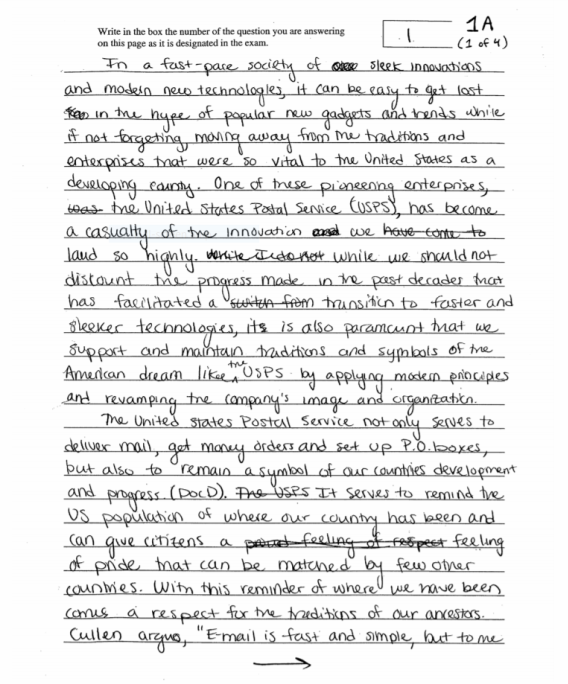
The B example also spurs interest with an anecdote to warm the reader to the subject of the essay. Unlike the A essay, however, this one positions the claim in the middle of a long introduction that begins discussing the supporting points that belong in the body paragraphs.
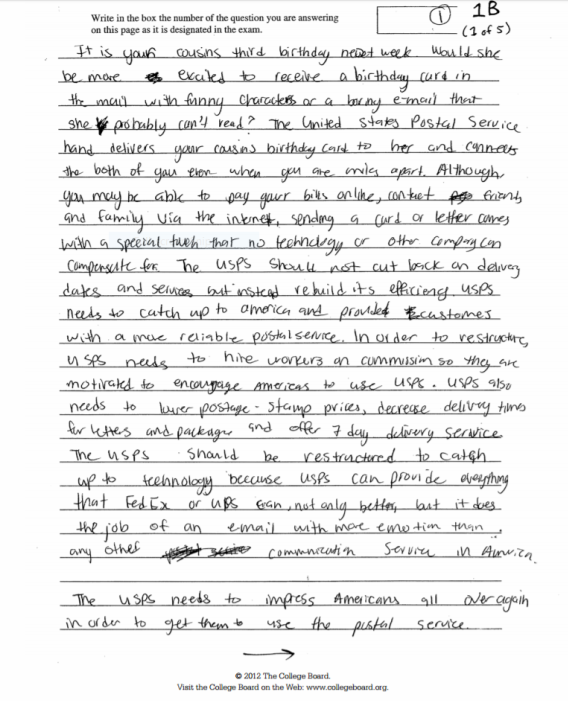
The B introduction previews the essay argument to guide the reader, but not as clearly as the A essay, although far more completely than the C, which merely states the claim in general terms, “for the following reasons”.
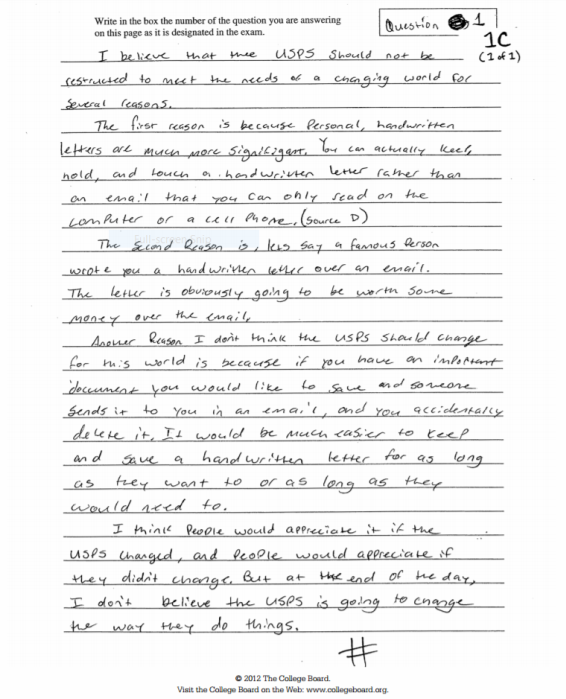
In sum, make introductions focused, compact, and precise. Good introductions inform, spark interest, and focus the essay’s main idea in an organized paragraph.
Use Source Facts and Opinions to Support Your Argument Points and Discuss them
The A answer models how to begin each paragraph with a clear topic sentence that furthers the claim and then adeptly supports the topic sentence. In the introduction, the A writer asserts the USPS is a symbol as well as a provider of postal services. Logically, the first paragraph begins with proving that assertion. The second sentence explains and exemplifies how the USPS is a symbol. Afterward, the student seamlessly weaves together assertions, quotes or paraphrases, and discussion in dense paragraphs. Sources are introduced by author or in parenthetical citations. Since economy is critical, the writer makes every sentence count.
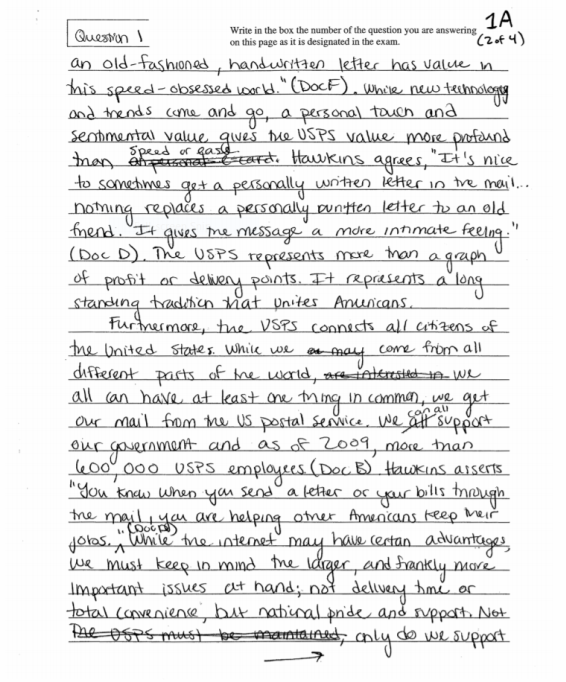
Through a methodical process of presenting topic sentences, supported with quotes, facts, opinions, and discussion, the A writer demonstrates keen reasoning and composition skills. The essay proceeds logically from the introduction to the conclusion with well-chosen details and proper sourcing to make the student’s points clear. For example, the writer’s order proceeds from the importance of the USPS to the suggested USPS revisions. Throughout, transitions (“furthermore”) reinforce the relationships between paragraphs.
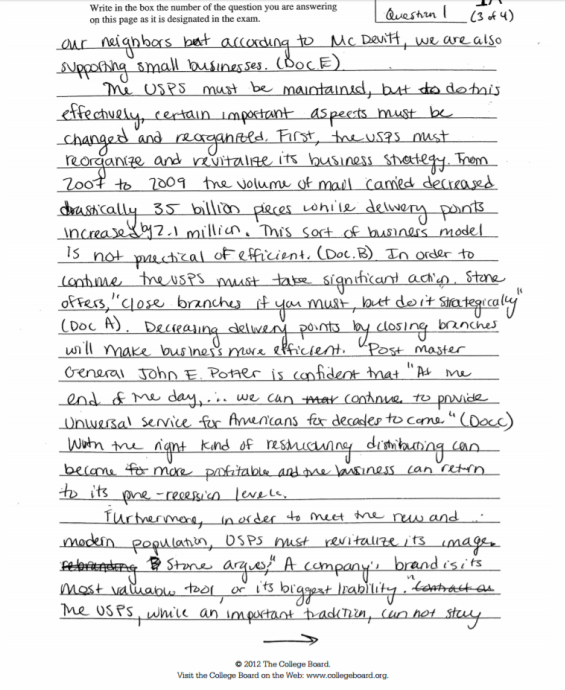
The mid-range sample, on the other hand, struggles to maintain clarity and consistency. Like the A essay, the B essay body paragraphs contain a topic sentence and examples, but the writer explains some examples (the first body paragraph’s point about extending services) but no others (hiring commission and specialized workers). Additionally, the student cites sources inconsistently. The writer doesn’t stick to the A formula of assertion, support, and citation, but generalizes and omits discussion of the main points in support of the claim.
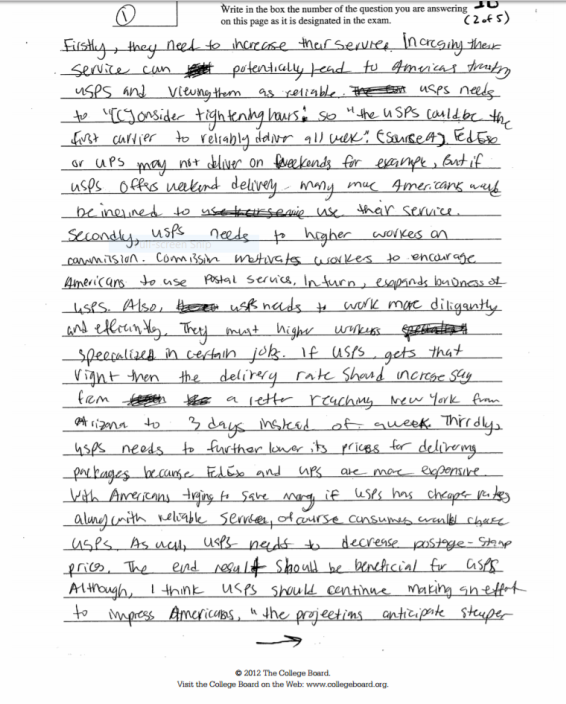
As the CollegeBoard warns, you don’t want merely to summarize sources. The B response does just that in the second body paragraph. Instead of using the source to support the idea that letters are still a source of joy the USPS offers, “to keep in touch with family and friends,” the writer uses anecdotal experience (“I know I’m fiercely tearing away at the envelope”) and summarizes the D source. Moreover, the source is not used authoritatively to support the second point to the claim since the writer just incorporates it into a personal story.
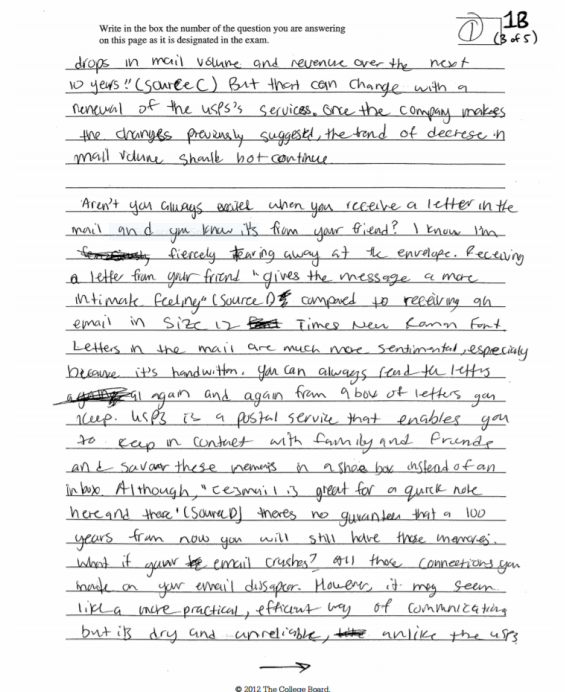
Sample C needs fully developed, clear topic sentences throughout the essay. The first body paragraph starts with an assertion that letters are much more significant as a reason to keep the USPS unchanged. To illustrate, the writer provides: “You can actually feel, hold, and touch a handwritten letter…” without explaining how that’s significant. There’s no discussion tying the example to the topic sentence. Also, all three words–feel, hold, and touch–waste precious time by repeating the same thing (you can feel a letter not an email).
Write a Brief Conclusion
Conclusions leave the reader satisfied and give the writer one last opportunity to cement the argument points and claim in the reader’s mind. If you run out of time, however, omitting the conclusion is not as fatal to your score as writing thin, underdeveloped, disorganized body paragraphs. A quick one or two sentence recap, like the A sample, rounds out thorough preceding paragraphs when nearing the time cut-off.
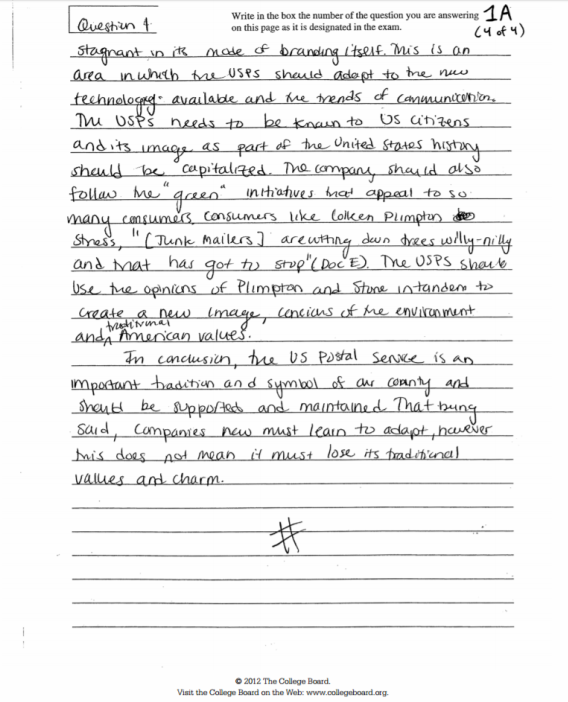
The A response uses the conclusion to tie together succinctly the three points of the preceding paragraphs: the USPS as tradition, the USPS as symbol, and the USPS modernized but not lost. The writer achieves the dual purpose of recapping and reminding the reader of the claim in the introduction without repeating the claim verbatim.
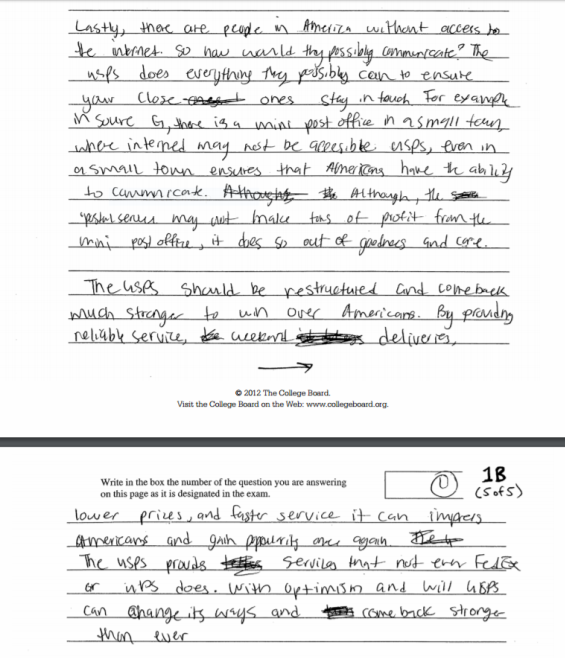
Conclusions are not for introducing new ideas or points not previously discussed in the body paragraphs. The B essay recaps some but not all points made in the essay but also presents the fact that the USPS provides services other carriers don’t. The disorderly ending doesn’t persuade as well as the A’s shorter but clearer restatement, although it is better than C’s vague opinion that doesn’t restate the claim, propose action, or tie up the essay.
Finally, a conclusion compositionally rounds out your essay so that your reader doesn’t struggle with any part of your essay. By repeating recapped points or fleshing them out with insights, you help the reader pull the argument together and wrap up.
Free Response Question #2
The 2012 AP® English Language and Composition exam, Free Response Question 2, required test takers to read the given commentary by John F. Kennedy from a 1962 news conference and write an essay that does the following:
- Analyze Kennedy’s rhetorical strategies used to achieve his purpose (the assumption being you identify the purpose).
- Support the analysis with “specific references to the text”.
Whereas the first FRQ required test takers to synthesize broad ideas, facts, and writing points in three sources (or portions of them) as support, this second question is different. It requires a closer reading and analysis of one source, forcing writers to tease out meaning from the fewer words and facts in a page and a half commentary.
Introduction and Thesis Statement
The a essay.
The writer packs the first sentence with strong verbs (“condemned,” “appeals”), details (“raising steel prices”), description (“communal sacrifice,” “collective responsibility,” and “every man audience”), and direction (claim: Kennedy exhorts “outrage” over raised steel prices).
Then, the student identifies the rhetorical stance of the speaker, Kennedy, with one of the “185 million Americans” against the “handful” of greedy “steel executives” and establishes the tone of the argument as “righteous indignation”.
The sophisticated vocabulary, confident weaving of source facts, and keen analytical ability (astute observation about the point of view) lend credibility to the writer’s argument immediately.
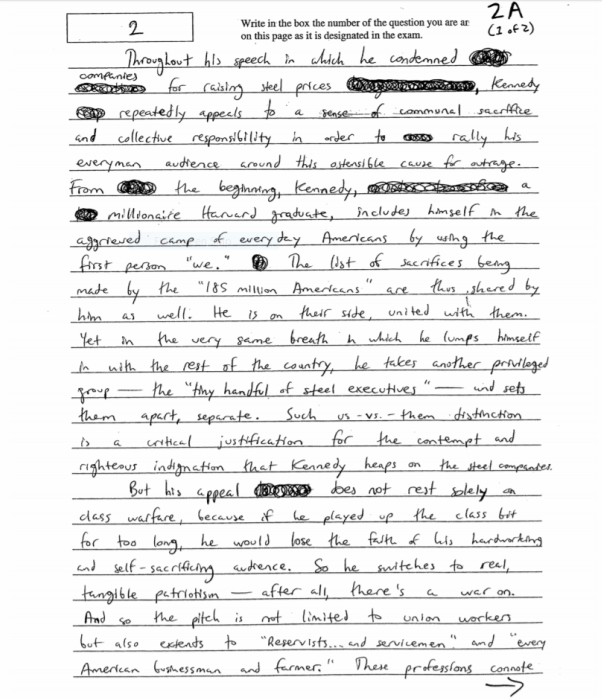
The B Essay
Unlike the economy of the A essay, the B response uses one sentence of a short introduction to repeat the prompt. While the introduction adequately covers the claim and rhetorical strategies, it does so without as much specificity as the A response, opting instead for vague language (“strong diction”) and off-the-mark tone description (Kennedy’s a little more than “disappointed”). By the end of the introduction, the reader understands the essay will touch on tone and diction in analyzing Kennedy’s posited aim to get the steel companies’ price reversal.
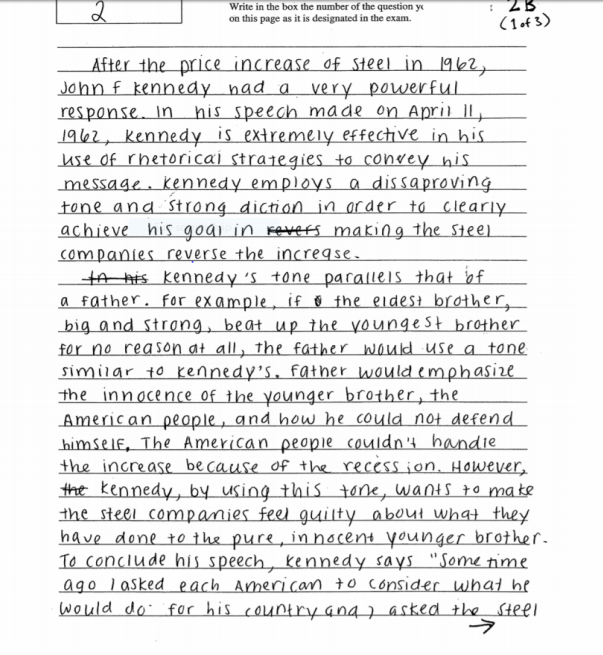
The C Essay
The C introduction lacks specificity and focus. It does not include a claim or address what’s required by the directions. The “it” in “JFK… was able to present it in a way that it was accessible” has no antecedent (what does the “it” refer to?), and the sentence, like the entire introduction, is vague and unclear. The writer shows little understanding of the meaning of “rhetorical strategies”.
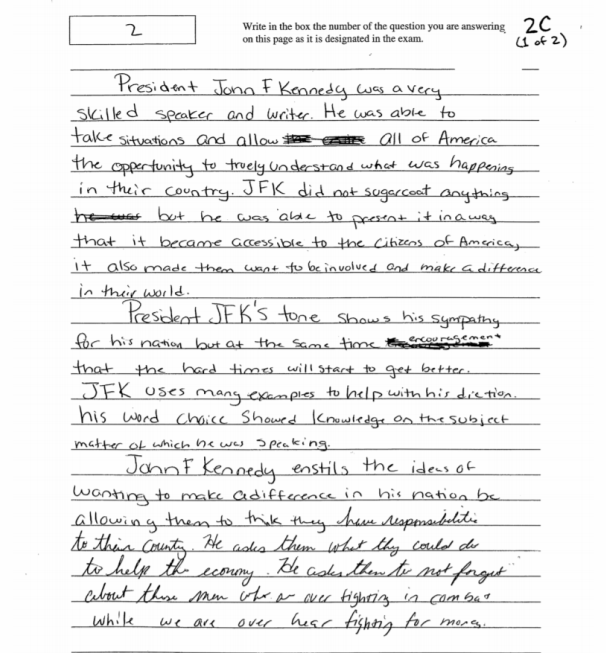
Exemplification, Citation, and Discussion in the Body Paragraphs
Hinging on the word “appeal” from the introduction, the A writer moves in the first body paragraph to Kennedy’s patriotic as well as class appeal. The student cites the text to seamlessly connect the source with the support in a grammatically correct incorporation of quotations into the student’s writing (“but also extends to ‘reservists… and servicemen’”).
The student then expands on the significance of calling upon those specifically addressed in the commentary–servicemen, businessmen, and farmers–to invoke quintessentially American citizens and ideas, hard-working, rugged individualists. The essay proceeds in this highly succinct, fluid pattern of drawing on source language to further each point until the end.
Throughout the body paragraphs, the writer demonstrates confidence and control over language, ideas, and composition skills. The student analyzes methodically, pulling out specific words and devices (“rhetorical caution” in the third paragraph) to reach complex conclusions synthesized from the passage’s language. No statement is left unexplained, and each paragraph begins with a pinpoint focused topic sentences bolstered by transition words that logically connect sentences and paragraphs to cohere all paragraphs to the claim.
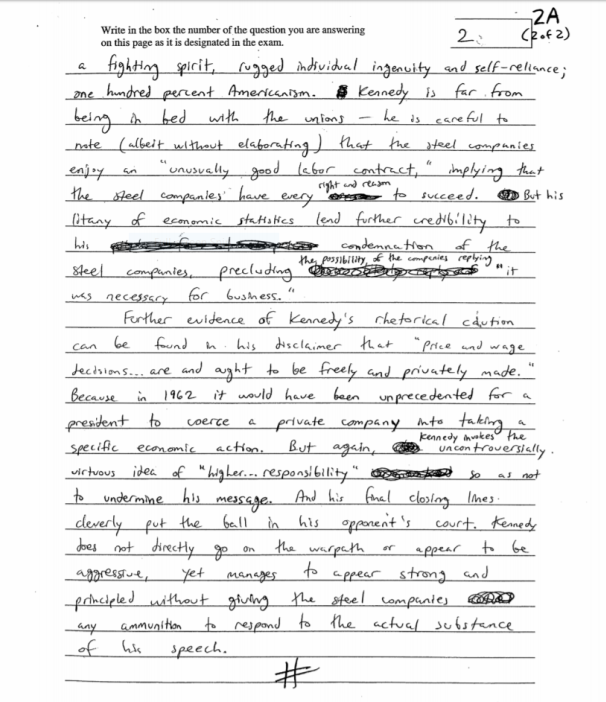
The first body paragraph begins with the “disappointing tone” from the introduction, a good segue into the body of the essay. However, the writer then spends too much time on an analogy between a parent and Kennedy to the nation, taking up valuable time that could be used to incorporate sources in making the point about tone. The first quoted excerpts come mid-way through the paragraph. The student could have spent more time explaining how the quoted language connotes disappointment rather than continue the hypothetical parent example, which dilutes the point. The essay clearly lacks the compactness of the A model.
The broad language, like “well-chosen diction,” and “exceptional word choice” leave the readers scratching their heads to the meaning. The examples of exceptional words “utter contempt” and “tiny handful” don’t clarify the point. The reader must glean the student’s assertion that the diction is effective since there’s no explanation.
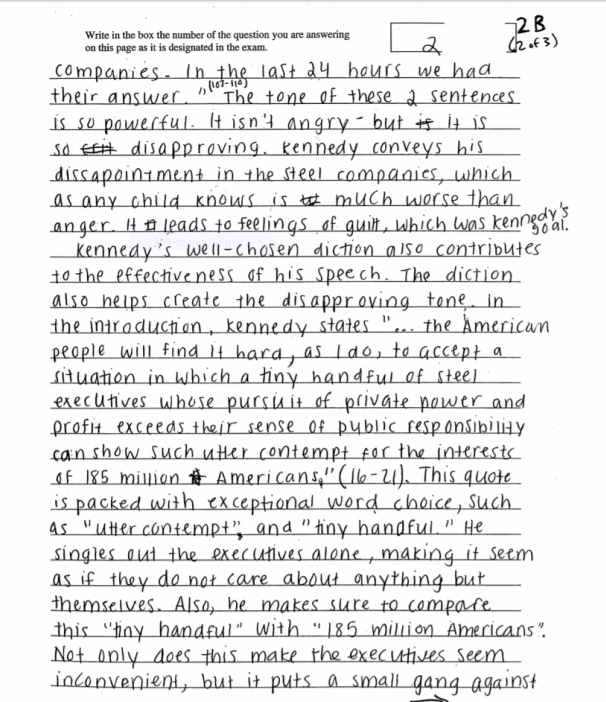
This essay is a shallow analysis, using no direct quotation or specific reference to the commentary until the final body paragraph when the writer finally tackles rhetorical strategies, such as repetition and a restatement of the “Ask not what your country can do for you” reference. The essay primarily summarizes the text content and mentions rhetorical devices but doesn’t exemplify “listing” and “details”. The writing also contains many spelling errors.
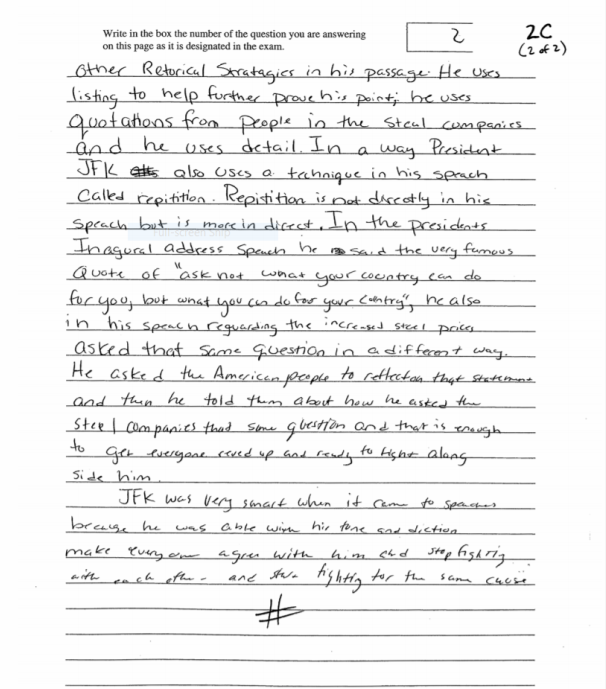
Conclusions
None of the essays make grand conclusions, but only the A essay ends concurrently with the writer’s final point and JFK’s parting remark. The other two end with brief paragraphs, the B restating the claim in a sentence and the C winding up with admiration for JFK’s ability to stop people from fighting, a random point. Even though the A essay doesn’t devote a separate paragraph to conclude, it does leave the reader with a sense of completion, ending with the final point in the essay synced to the overall effect of Kennedy’s speech as strong without capitulating.
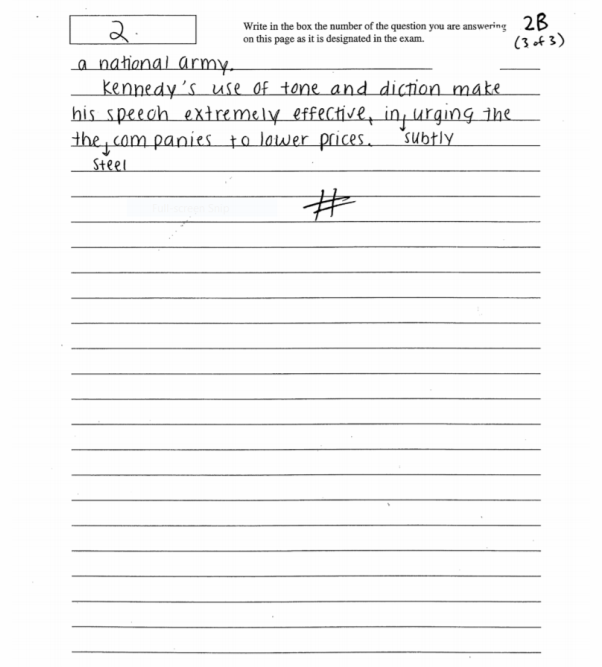
The Free Response Question #3
The year’s third question poses two quotations, one by William Lyon Phelps, educator, journalist, and professor, and the other by Bertrand Russell, British mathematician, writer, and philosopher, on the nature of certainty and doubt. The prompt requires examinees to write an essay that
- Defends a position about the relationship of doubt and certainty
- Supports the argument with appropriate evidence and examples
Broader than the two preceding questions, this open question requires the student to draw on personal experience or the world to demonstrate the ability to concretize two abstract terms with examples and explanation. The attention to detail, economy, and specificity are critical to successfully anchoring the words to concrete examples. Writers must resist the temptation to define abstract terms with generalizations and vague ideas.
Introductions and Thesis Statements
The top essay gets right to the heart of defending a position. It defends a relationship of certainty to doubt by alluding to the first quotation in summary fashion–certainty is the key to achieving your dreams. The writer then moves on to doubt by first defining it, and then showing its relationship to certainty: “Doubt is what allows us to question and challenge those certainties”. The final sentence of the introduction contains the claim, which all of the preceding sentences lead to in an organized and clear opening to the essay.
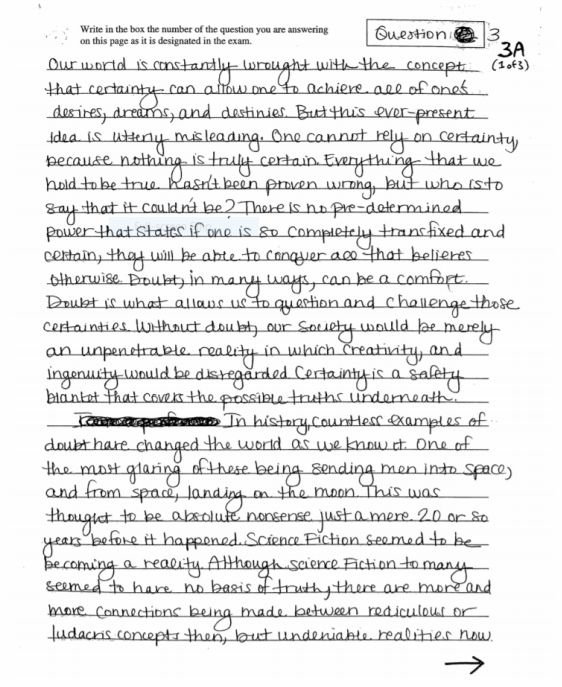
Like the B responses of the two prior sections, the introduction lacks a clear organization, and the language is vague and loose. This short introduction starts out strong by acknowledging a truth about certainty and how doubt fits into that truth. However, by the last sentence, the apparent claim, the ideas become unclear, awash in vague terms like, “the right times,” or “certain times” and entangled in a wordy sentence (“to show through as a more prominent feeling”). Without a clear thesis statement or claim, the reader is unsure where the essay will go.
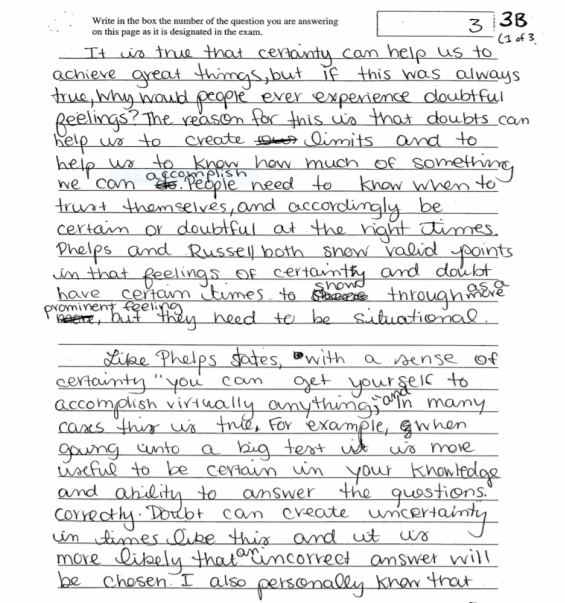
The third introduction melds into the entire essay, which is one page-long paragraph. The first sentence promises to tackle the certainty concept, but it immediately turns to agreeing with the Phelps quote with one personal anecdote as proof. It’s difficult to decipher where the introduction ends and the essay body begins.

Exemplification and Discussion
Like the model essays before it, this sample successfully organizes each paragraph with a clear topic sentence that seamlessly connects with the preceding paragraph (“In history, countless examples of doubt have changed the world” connects with the last sentence in the introduction about “doubt”).
The next order of business after introducing the claim is locating examples that illustrate the relationship between certainty and doubt. The A writer chooses history. The topic sentence encompasses the main idea that history shows significant instances of doubt, and the following sentences prove that assertion with details about moon landings and other seemingly fictional possibilities that turn into reality. The student elaborates on the idea in a full paragraph that makes the topic sentence clear.
The A essay also contains clear transitions to connect paragraphs together and paragraphs to the thesis statement. For example, the second body paragraph begins, “One of the most important components of doubt is trial and error”. In defending the claim, the writer teases out the meaning and character of doubt.
After exemplifying with Thomas Edison’s discovery based on trial and error, the writer goes on to “another example,” which starts off the final body paragraph. The trail from thesis statement to conclusion is methodical and organized. The order of least to most important–technological advancements to religion–leaves the reader with a strong impression of the writer’s compositional capability and keen insights.
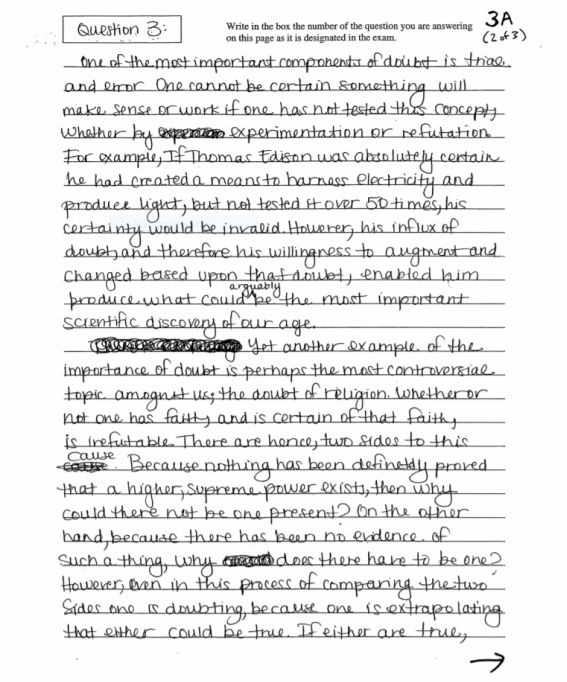
This response also contains insights about the relationship of certainty and doubt (sometimes doubt can mean the difference between living and dying) and examples from history and literature, but the explanations that connect the examples to the point of each paragraph are unclear. The writer uses vague language (“in certain circumstances,” “the right mindset,” “in a bigger, more important view” and less obvious facts (the confidence of the colonists). However, the B writer gets the job done though not without some confusion and work on the reader’s part.
The last example from literature had the potential to exemplify the necessity for doubt, but the reader who hasn’t read the referenced book doesn’t know what the main character did or did not do in the name of confidence. The example is not obvious without a one sentence contextual summary of the character’s behaviors that led to his death might have strengthened the example.
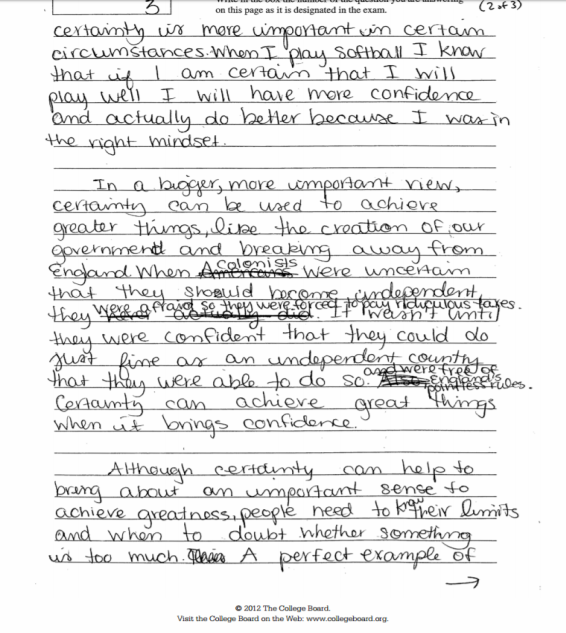
The last example essay uses a personal anecdote of winning a lacrosse game by confidence to agree with the Phelps quote. However, the example is a mere conclusion and a hasty generalization. One incident does not exemplify the broad scope of the quote, which the writer interprets as confidence leads to success.
Without more than a conclusion that the team was confident and the team won, there’s little to no support for the claim, which is that the writer agrees with the Phelps quote. More explanation and detail are necessary to make the example illustrative of the relationship between confidence and doubt. The entire essay needed more: content, order, examples, and paragraphs.
All three essays conclude, but the first one clearly does the best job of winding up the argument. The writer uses the conclusion to reinforce and broaden the reach of the claim that doubt compels creativity to other historical figures not mentioned in the body of the essay. All final examples in the A response support the last comments. They don’t open up a new claim or supporting premise. The last line hammers the essential point home declaratively.
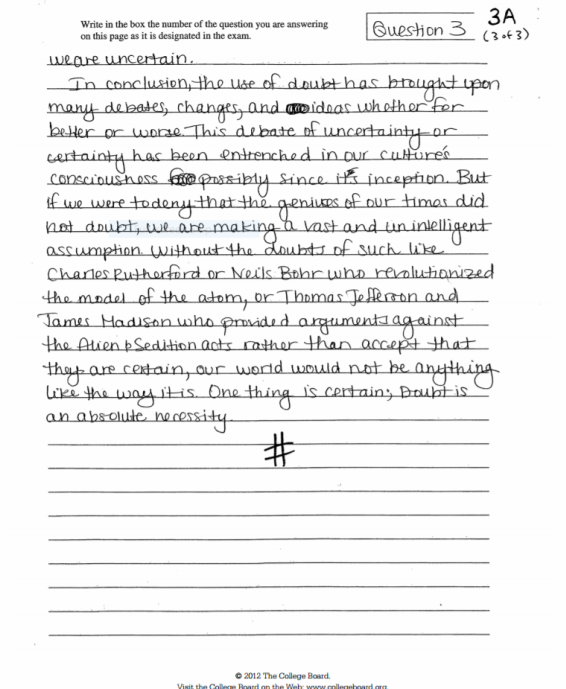
The B and C conclusions, however, don’t satisfy. Consistent with the rest of the essay, the B essay ends vaguely with broad terms that don’t form clear images or ideas: “appropriate time,” “achieve great things,” and “limits available to a person”. The writer needed to specify what’s appropriate, which things, and rephrase “limits available” as the phrase makes little sense. However, the C essay does worse, shifting into second person point of view to instruct the reader in the end. The writer veers off course and doesn’t, in fact, conclude the essay started in the introduction.
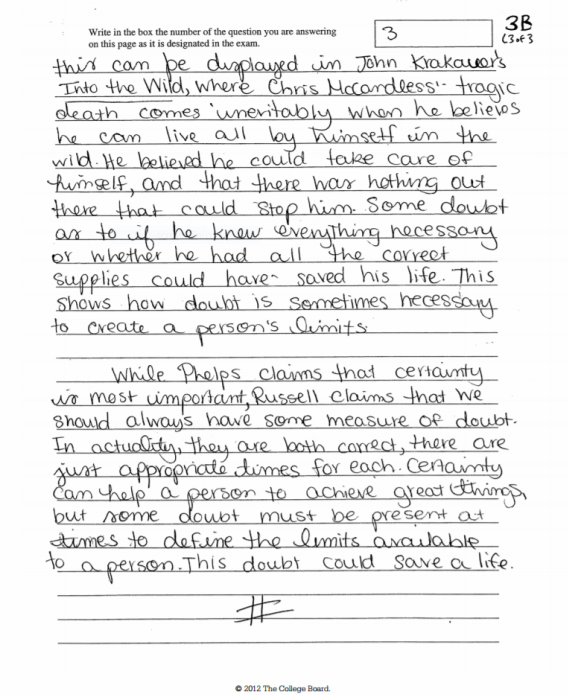
Write in Complete Sentences with Proper Punctuation and Compositional Skills
As you can see from all nine samples, writing counts–heavily. Though pressed for time, it’s important to write an essay in concise sentences with words both precise and economical. Choosing strong verbs and adjectives vivify and crystallize your ideas. Fragments and misspelled words cause confusion and weaken your argument. Additionally, sound compositional skills create a favorable impression on the reader.
You want your essay to read smoothly, without the reader having to re-read sentences to figure out what you mean. Using appropriate transitions or signals (furthermore, therefore) to tie sentences and paragraphs together solidifies relationships between sentences and paragraphs (“also”–adding information, “however”–contrasting an idea in the preceding sentence), making your essay organized and clear.
Starting each paragraph with a clear topic sentence that previews the main idea or focus of the paragraph helps both writer and reader keep track of each part of the argument. Each section furthers your points on the way to convincing your reader of your argument. If one point is unclear, unfocused, or grammatically unintelligible, like a house of cards, the entire argument crumbles. Excellent compositional skills help you lay it all out orderly, clearly, and completely.
So by the time the conclusion takes the reader to your parting words, you have done all of the following:
- followed the prompt
- followed the propounded thesis statement in exact order promised
- provided a full discussion with examples
- included quotes, paraphrases, and citations, proving each assertion
- used clear, grammatically correct sentences
- written paragraphs ordered by a thesis statement
- created topic sentences for each paragraph
- ensured each topic sentence furthered the ideas presented in the thesis statement
Have a Plan and Follow it
It takes discipline to lay out an order, a strict time limit for each essay, and stick to them. To score high on the AP® Language and Composition FRQs, practice planning responses under tight time constraints. Write as many practice essays as you can. Follow the same process each time.
First, be sure to read the instructions carefully, highlighting, circling, or underlining the parts of the prompt you absolutely must cover. Then quickly pencil a scratch outline of the order you intend to cover each point in support of your argument. You should write a clear thesis statement, written as a complete sentence, as well as the topic sentences to each paragraph. Then quickly write underneath each topic sentence, the quotes and details you’ll use to support the topic sentences. Then refer to your outline often and follow it faithfully.
Be sure to give yourself enough time to review and revise. Give your essay a brief read over to catch mechanical errors, missing words, or necessary insertions to clarify an incomplete or unclear thought. With time, an organized approach, and plenty of practice, earning high scores on the AP® English Language and Composition FRQs is attainable. Be sure to ask your teacher or consult other resources, like albert.io’s English Literature practice essays, if you’re unsure how to identify poetic devices, prose elements, or just need more practice writing literary analyses.
Looking for AP® English Language practice?
Kickstart your AP® English Language prep with Albert. Start your AP® exam prep today .

Interested in a school license?
Popular posts.

AP® Score Calculators
Simulate how different MCQ and FRQ scores translate into AP® scores

AP® Review Guides
The ultimate review guides for AP® subjects to help you plan and structure your prep.

Core Subject Review Guides
Review the most important topics in Physics and Algebra 1 .

SAT® Score Calculator
See how scores on each section impacts your overall SAT® score

ACT® Score Calculator
See how scores on each section impacts your overall ACT® score

Grammar Review Hub
Comprehensive review of grammar skills

AP® Posters
Download updated posters summarizing the main topics and structure for each AP® exam.
Get in touch with us
Are you sure you want to logout?
Study abroad.

AP Lang Rhetorical Analysis Essay
AP language exams are held for numerous subjects. Students have to choose a specific subject and get higher scores. The higher the score, the higher the chance of pursuing the best 700 colleges or universities overall in the world, including the United States and Canada.
When it comes to AP English language, it involves a section called rhetorical analysis essay. This is a part of three free-response essays that have to be answered within 2 hours and 15 minutes from the overall 3 hours 15 minutes exam.

If you are taking the AP Lang exam this year, guidance on how to answer this part will be useful. This article is specially curated to help you score the best. Read on to learn more about the AP language rhetorical analysis essay and get an idea of how to prepare for the associated exam successfully.
What is the AP Lang Rhetorical Analysis Essay ?
AP elaborated that the Advanced Placement is the exam conducted by the College Board in the United States of America. The exam is generally offered at the high school level and helps students to pursue higher education at the university level. The exam holds two sections: MCQs and Rhetorical Essay. MCQ sections are for 1 hour, and the rest of the time is for the essay section. The free-response essay holds three essays: rhetorical analysis essay, synthesis essay, and argumentative essay.

- The rhetorical analysis essay in the AP Lang exam involves students having to discuss how the authors’ contribution to the passage gives a theme or meaning.
- A synthesis essay involves students creating arguments on the passage or piece of information delivered to them.
- An argumentative essay requires students to pick a side ‘for or against ‘ for an argument or debate.
Since we are here to discuss rhetorical analysis essays in AP language, you must know the essay is added to test students’ ability to analyze and interpret the deeper meaning in the provided passage. Through rhetorical essays, the examiner examines how students connect with the author’s style of writing and syntax within 40 minutes. Some students may face challenges while dealing with this essay because it requires a better understanding of rhetorical strategies and the method to apply them.
Tips to Write a Rhetorical Analysis Essay AP Lang ?
Since a rhetorical essay is quite tricky in comparison to other essays, it requires certain tips for a better approach to answering. Let us explore the method of writing a rhetorical essay for the AP Lang exam that helps you score well.

- Outline Essay Prior to Writing
Not only good content but providing a readable structure is an important part of the rhetorical analysis essay AP Lang . First, you must read the passage thoroughly and develop a brief outline or key points before writing the essay. This helps you write with respect to the chronology of the given passage and maintain the flow of writing.
- Understand Rhetorical Strategies
You aren’t alone in thinking about where to start writing a rhetorical essay. Many students face the same and are required to learn and implement rhetorical strategies. First, understand what rhetoric actually means. It refers to language sensibly chosen and structured for an impressive effect on the audience. This involves persuasive appeal, logical fallacies, and syntax such as anaphora, anthesis, parallelism, and so on. There is a vast range of elements that you can assess in the provided essay and develop a strong grasp with consistent practice.

- Make your Essay Well-Structured
Sometimes, students understand the rhetorical strategies but still get confused about where to initiate. It is recommended to start with an introduction that delivers the purpose of your writing. In the last introductory line, you must talk about the rhetorical strategies you will discuss in the piece. However, there are so many styles, syntax, and tones. You must be specific while listing them and then move to develop a body paragraph.
Now, you have to collect all the rhetorical strategies you mentioned in the introduction to discuss your point of view chronologically. Be specific while discussing strategy, as only the crucial ones among them must be discussed. Never forget to cite the line from the original passage. Your write-up must maintain the flow and should include relativity among the paragraphs. End the rhetorical essay by summarising key points.

- Never Forget to Explain your Examples
Do not just state the examples or deliver statements like ‘this is an example of pathos or logos.’ It is advisable to explain the example you have listed in context to the rhetorical elements you have mentioned and how it aids the author in their viewpoint. Stay detailed yet precise while writing the rhetorical analysis essay AP Lang .
AP Lang Rhetorical Analysis Essay Rubric
Did you know that the rhetorical analysis essay AP Lang is graded into three rubric categories? Students must pay heed to the categories, as the examiner seeks specific things in each of them. Also, learn about some dos and don’ts to score well.

When it comes to grading the thesis of the rhetorical analysis essay AP Lang , there is nothing nebulous. Either you get one point, or you lose one. Thesis points help you get close to higher scores, and thus, you must be mindful of the following points.

- Developing an argument states that your interpretation leads to a risk of disagreement. Thus, your thesis statements must be in context with the author’s rhetorical choice.
- If you create a phrase in your mind initiating with ‘I think that..’, your phrase should not go in a negative argumentative direction.
- Never provide a thesis with summaries but not an argument.
- Try not to provide the thesis with repeated prompts.
Evidence is provided to prove the argumentative context in the thesis. This rubric category is graded from 0 to 4 points. To score higher, you must follow the points below.
- You must aim to provide multiple types of evidence in your argumentative thesis.
- Each statement you provide must be backed up with evidence in context to the text or arguments about the author’s theoretical choices.
- Add more and more evidence, which must be specific.
- Examine whether your evidence is linked with your overarching argument.
- Deliver your interpretation and never rely on just quotes or phrases.
- Steer clear of generalization for text or author
- Avoid quotes that speak for themselves. You must elaborate on the evidence you provided.
- Sophistication
According to The College Board, this category holds 0 to 1 points. The higher grading in rhetorical analysis essays indicates the delivery of the sophistication of thoughts or a complex understanding of rhetorical elements. In this, you have to mainly focus on the number of semicolons you use and not the fancy terms. Here is what you need to follow:
- Focus on delivering the right connection between the thesis and your evidence.
- Create a brief framework and then proceed with writing the essay in the right flow to stay precise and clear in your piece.
- Do not include arguments that you won’t be able to provide evidence for.
- Ignore complex or fancy words or phrases that are hard to follow.
Ways to Improve Your Rhetorical Analysis Essay AP Lang
Now that you know what a rhetorical analysis essay is and how it is developed, you must be thinking about how tricky it is to understand the passage. Many find themselves in a completely blank position when it comes to where to begin during the exam. They find the rhetorical analysis essay AP Lang quite challenging to deal with and understand the author’s perspective and viewpoint. Practicing rhetorical strategies does not help if you do not have the right approach, which only comes from the field experts and their guidance. Turito offers a platform where you get mentors to teach you all the concepts and approaches you apply in writing effective rhetorical essays in less time. Their course helps you get higher scores, which you can use to get college admission to your favorite college and country. Hey, you ambitious one, what are you waiting for? Contact us now and give your dreams a flight!
Frequently Asked Questions
What courses do turito offer.
Turito offers several courses to help you prepare. Here are some of them for your reference. 1. Foundation Course 2. IIT JEE 3. NEET 4. Study Abroad 5. Universal Program 6. PSAT 7. AP 8. IELTS
Can I ask queries on Turito?
Yes absolutely! Turito offers a platform where you can ask your concerns and queries. You will get answers from the field expert that can let your worries fade away.
Is Turito genuine?
Turito is students’ most trusted learning platform, among others. Turito believes in transparency and thus provides genuine feedback from students and parents on the official website. At Turito, we offer guaranteed success for hardworking students. Thus, there isn’t any negative feedback to hide. If you have any queries, you can write to us at [email protected]. Our experts will connect and assist you in no time.
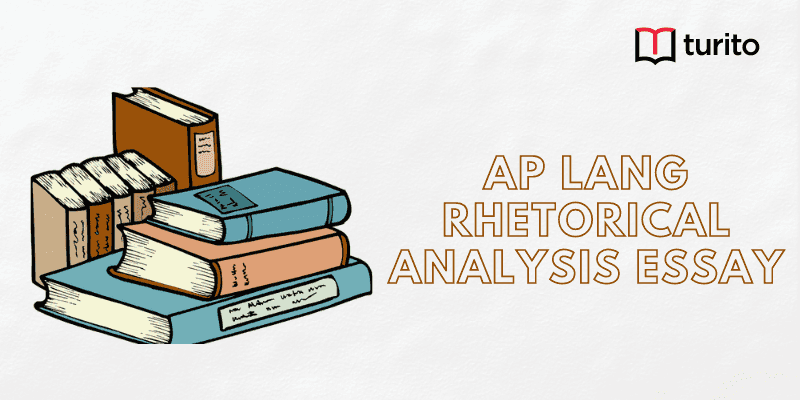
Relevant Articles
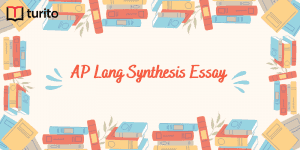
Steps to Draft AP Lang Synthesis Essay
The synthesis essay AP lang is part of the AP …
Steps to Draft AP Lang Synthesis Essay Read More »
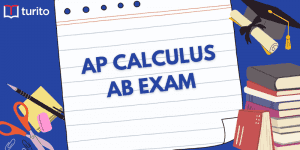
Strategies for Success: A Complete Overview of the AP Calculus AB Exam
The AP Calculus AB Exam serves as an important element …
Strategies for Success: A Complete Overview of the AP Calculus AB Exam Read More »

Preparing for Success: A Guide to the Features of Digital AP Exams
Digital Advanced Placement (AP) exams bring about a huge change …
Preparing for Success: A Guide to the Features of Digital AP Exams Read More »

With Turito Study Abroad

Get an Expert Advice from Turito

With Turito CAP.

With Turito Coding.

With Turito RoboNinja

1-on-1 tutoring for the undivided attention
Calculate for all schools
Your chance of acceptance, your chancing factors, extracurriculars, ap lang analysis essay.
I'm struggling with understanding the AP Lang analysis essay format and process. Can someone break down the steps for me or share resources that will help me tackle these essays?
Sure, I'd be happy to break down the steps for you. The AP Lang analysis essay, also known as the rhetorical analysis essay, requires you to analyze a text (usually a speech or an article) and explain how the author uses various rhetorical strategies to achieve their purpose.
Here are the steps you should follow:
1. Read the prompt: Carefully read the given prompt, which will provide you with the context and specific instructions for the essay.
2. Analyze the text: Read the provided text at least twice. The first reading should be a quick one, to get the overall gist. The second reading should be more focused, noting specific rhetorical devices, strategies, and examples of their use.
3. Take notes: As you read and analyze the text, jot down the main points, rhetorical strategies used, and specific evidence that support your analysis.
4. Create a thesis statement: Based on your understanding of the text and prompt, come up with a clear and concise thesis statement that outlines your main argument.
5. Outline your essay: Create a brief outline for your essay, which will include an introduction, body paragraphs (each focusing on one or two rhetorical strategies), and a conclusion.
6. Write the introduction: Begin with an engaging opening that provides context for the text and its author, and then introduce your thesis statement.
7. Write body paragraphs: For each body paragraph, start with a topic sentence that clearly outlines the rhetorical strategy you will analyze. Then, provide specific examples from the text to support your analysis, explaining how the author uses the rhetorical devices to achieve their purpose. Make sure you're focusing on analysis, rather than mere summarization of the text.
8. Write the conclusion: In your conclusion, restate your thesis statement and summarize the key points of your analysis. You can also offer implications or broader significance if relevant.
9. Proofread and revise: Carefully review your essay for clarity, grammar, and spelling errors, and make any necessary revisions.
For additional resources, consider checking out the College Board's AP Lang resources ( https://apcentral.collegeboard.org/courses/ap-english-language-and-composition) and CollegeVine ( https://blog.collegevine.com/how-to-write-the-ap-lang-rhetorical-essay/). Also, practice writing these essays under time constraints to get familiar with the process and improve your skills.
Remember, practice is crucial for mastering the AP Lang analysis essay format. Keep practicing, and you'll become more confident and adept at tackling these essays. Good luck!
About CollegeVine’s Expert FAQ
CollegeVine’s Q&A seeks to offer informed perspectives on commonly asked admissions questions. Every answer is refined and validated by our team of admissions experts to ensure it resonates with trusted knowledge in the field.
- Homework Help
- Essay Examples
- Citation Generator
Writing Guides
- Essay Title Generator
- Essay Topic Generator
- Essay Outline Generator
- Flashcard Generator
- Plagiarism Checker
- Paraphrasing Tool
- Conclusion Generator
- Thesis Statement Generator
- Introduction Generator
- Literature Review Generator
- Hypothesis Generator
- Human Editing Service
- Essay Hook Generator
Writing Guides / Mastering the Rhetorical Analysis Essay: A Comprehensive Guide
Mastering the Rhetorical Analysis Essay: A Comprehensive Guide
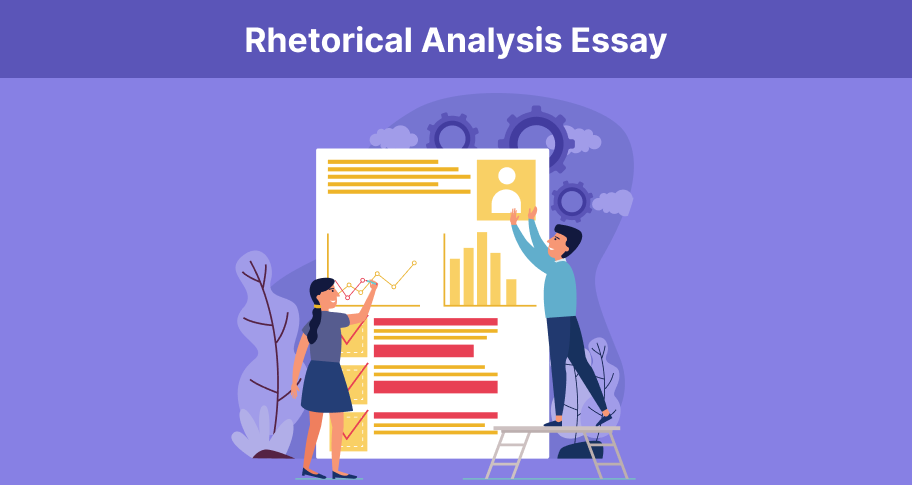
Introduction
Want to know how to write a rhetorical analysis essay that impresses? You have to understand the power of persuasion. The power of persuasion lies in the ability to influence others’ thoughts, feelings, or actions through effective communication. In everyday life, it plays a crucial role in shaping opinions, making decisions, and driving actions. Whether in personal relationships, professional settings, or public discourse, persuasion helps individuals advocate for their ideas, negotiate solutions, and motivate others toward desired outcomes. Mastering persuasion can enhance leadership, improve negotiation skills, and foster better interpersonal connections.
A rhetorical analysis essay examines how an author or speaker uses language and rhetorical strategies to persuade their audience. The purpose of this type of essay is to analyze the effectiveness of these techniques in achieving the author’s goals. This involves looking at various elements, such as the use of ethos (credibility), pathos (emotional appeal), and logos (logical arguments), as well as the author’s style, tone, and structure. By understanding how these elements work together to influence the audience, the essay provides insight into the power and impact of the author’s message.
Understanding rhetorical strategies is valuable for several reasons: critical thinking, effective communication, enhanced persuasion, improved audience awareness, and analytical skills. Rhetoric enhances your ability to analyze and evaluate arguments. By recognizing how persuasive techniques are used, you can better assess the strengths and weaknesses of different viewpoints and arguments.
Knowing rhetorical strategies helps you craft your own arguments more persuasively. Whether writing, speaking, or engaging in debate, you can use these strategies to connect with your audience and convey your message more compellingly.
Understanding these strategies allows you to influence others more effectively. By applying appropriate rhetorical techniques, you can better achieve your goals in personal, professional, and public contexts.
Rhetoric helps you tailor your message to the needs and preferences of your audience. By understanding what appeals to different audiences, you can adjust your communication to be more effective. It also develops your ability to dissect complex texts and speeches, leading to a deeper comprehension of both the content and its delivery. This skill is beneficial in both academic and everyday contexts. Overall, mastering rhetorical strategies equips you with the tools to both critically evaluate and create persuasive messages.
In this article, we will examine the various elements of a rhetorical analysis essay. We will start by understanding the basics of rhetoric, cover the steps to writing a rhetorical essay, provide an example essay, and finish with tips.
Understanding the Basics of Rhetoric
Before you can write a rhetorical analysis essay, you have to start by defining rhetoric. Rhetoric is the art of persuasion through effective communication. It involves using language strategically to influence, convince, or inform an audience. Rhetoric aims to achieve a specific goal, such as persuading an audience to adopt a particular viewpoint, take action, or understand a concept. Effective rhetoric takes into account the audience’s needs, values, and emotions. Understanding your audience helps tailor your message to resonate with them.
Rhetoric uses ethos, pathos, and logos to persuade. Ethos establishes credibility and trustworthiness. It involves demonstrating authority or expertise on the topic. Pathos appeals to the audience’s emotions, aiming to connect on an emotional level and create a response. Logos uses logical arguments and evidence to persuade through reason and rationality.
Rhetoric also involves choosing the right style and delivery methods. This includes the use of language, tone, structure, and persuasive techniques to convey the message effectively. The effectiveness of rhetoric often depends on the context in which it is delivered, including cultural, social, and situational factors. Overall, rhetoric is a crucial skill in various fields, including politics, business, and personal communication, as it enables individuals to influence and engage others through their use of language effectively.
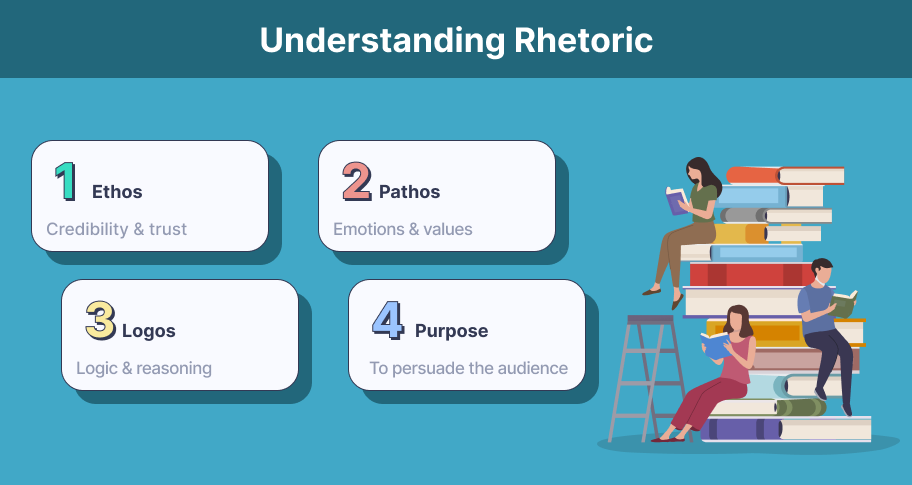
The Rhetorical Situation
The rhetorical situation encompasses the various elements that define and shape the act of communication. Understanding these elements helps in crafting compelling messages and analyzing how they work.
The speaker or writer is the individual or entity delivering the message. This can be a person, a group, or an organization. The speaker’s credibility, background, and perspective play a significant role in how the message is received. Understanding the speaker’s ethos, or their character and authority on the subject, is crucial for evaluating their arguments.
The audience is the recipients or target of the message. The audience includes the individuals or groups who will read, listen to, or view the communication. Knowing the audience’s characteristics, such as their interests, values, and prior knowledge, helps tailor the message to effectively reach and engage them. Audience analysis helps predict how the message will be perceived and how to address potential objections or questions.
The purpose is the goal or intention behind the communication. The purpose defines what the speaker or writer aims to achieve with the message. This could be to persuade, inform, entertain, or motivate the audience. Clearly defining the purpose helps in structuring the message and focusing on the key points that need to be communicated. The effectiveness of the communication often hinges on how well the purpose aligns with the audience’s needs and expectations.
The context is the surrounding environment or situation in which the communication occurs. Context includes the time, place, cultural, social, and situational factors that influence the message. It can affect both the content and delivery of the communication. For instance, a message delivered during a political campaign may have different implications than the same message delivered in a casual social setting. Understanding the context helps in addressing relevant issues and ensuring the message is appropriate and effective for the given situation.
By analyzing these elements, you can gain a deeper understanding of how effective communication operates and how to craft messages that are appropriate for specific situations and audiences.

The Rhetorical Triangle (Ethos, Pathos, Logos)
The rhetorical triangle consists of three key elements—ethos, pathos, and logos—that work together to create persuasive and effective communication.
Ethos refers to the credibility and ethical appeal of the speaker or writer. Establishing ethos involves demonstrating expertise, reliability, and trustworthiness. It’s about convincing the audience that the speaker or writer is knowledgeable and has a good character, making them credible sources on the topic. Ethos can be established through:
- Professional Experience : Showcasing relevant qualifications or experience.
- Reputation : Leveraging a solid reputation or previous successes.
- Tone and Presentation : Using a respectful and professional tone and presenting information clearly and accurately.
- Alignment with Values : Connecting with the audience’s values and beliefs to build trust.
Pathos refers to the emotional appeal used to persuade the audience. Pathos involves tapping into the audience’s emotions to create a connection and influence their attitudes or decisions. By evoking feelings such as sympathy, anger, joy, or fear, the communicator can make the message more compelling and memorable. Techniques for using pathos include:
- Anecdotes : Sharing personal stories or testimonials that resonate emotionally.
- Imagery : Using vivid language and imagery to evoke specific feelings.
- Emotional Language : Employing words and phrases that elicit emotional responses.
Logos refers to the logical appeal based on reason and evidence. Logos involves using logical arguments, facts, statistics, and reasoning to persuade the audience. It’s about presenting a well-structured argument supported by evidence that appeals to the audience’s rationality. Effective use of logos includes:
- Evidence : Providing concrete data, examples, and facts.
- Reasoning : Using clear, rational arguments and logical connections.
- Clarity : Presenting information in a coherent and organized manner to facilitate understanding.
The rhetorical triangle demonstrates how ethos, pathos, and logos interact to create persuasive messages. Ethos builds credibility, pathos appeals to emotions, and logos relies on logic and evidence. Effective communication often involves balancing all three elements to engage the audience and achieve the desired outcome.
Rhetorical Devices and Strategies
Writers use various rhetorical devices in essays and strategies to help persuade their audience. Understanding these devices is critical when you want to write an effective rhetorical analysis essay because you need to be able to recognize them and analyze them in your source material.
A metaphor is a figure of speech that compares two unlike things by stating one is the other, suggesting a similarity between them. “Time is a thief” is an example of a metaphor. Metaphors help make abstract concepts more concrete and relatable, enhancing understanding and emotional impact.
A simile is a figure of speech that compares two unlike things using “like” or “as.” “Her smile was like sunshine” is an example of a simile. Similes clarify ideas and evoke imagery, making arguments more vivid and engaging.
Repetition refers to the intentional repetition of words or phrases to emphasize a point or theme. One of the most famous examples of repetition is in Dr. King’s I Have a Dream speech. Repetition reinforces vital messages, making them more memorable and persuasive.
Alliteration is the repetition of the same initial consonant sound in words that are closely positioned. Many tongue-twisters feature repetition, like “Peter Piper picked a peck of pickled peppers.” Alliteration adds rhythm and emphasis, making phrases catchier and more engaging.
Hyperbole is an exaggerated statement that is not meant to be taken literally; it is used for emphasis. “I’ve told you a million times” is a hyperbole parents often use with their children. Hyperbole draws attention to critical points and conveys strong emotions or urgency.
The opposite of hyperbole is an understatement, which is deliberately downplaying the significance of something. “It’s just a small scratch” (when referring to a significant dent) is an example. Understatement can draw attention to the magnitude of an issue by minimizing it, often adding a layer of irony or emphasis.
An analogy is a comparison between two things that are alike in some respects, often used to explain or clarify. An example of an analogy is, “Just as a sword is the weapon of a warrior, a pen is the weapon of a writer.” Analogies help clarify complex ideas by relating them to familiar concepts, making arguments more understandable and persuasive.
Many writers use rhetorical questions, which are questions that they ask to make a point rather than to seek an answer. A politician asking, “Isn’t it time for a change?” is not seeking an answer but trying to encourage people to vote for them. Rhetorical questions engage the audience and prompt them to think about the issue, reinforcing the speaker’s position.
Irony is one of this writer’s favorite rhetorical tools. It refers to a contrast between expectation and reality, often used to highlight discrepancies. A fire station burning down is an example of irony. O’Henry’s short stories are some of the best examples of irony available. Irony can highlight contradictions or absurdities, adding humor or emphasizing a point.
It is essential not to overlook the role that pathos plays as a rhetorical tool. An emotional appeal uses emotions to persuade. Pathos creates an emotional connection, influencing the audience’s feelings and responses.
Devices like metaphors and similes clarify complex ideas by drawing comparisons to familiar concepts. Repetition, alliteration, and rhetorical questions make messages more engaging and memorable. Hyperbole, pathos, and irony tap into emotions, making the argument more compelling and relatable. Analogies and rhetorical questions encourage deeper thinking and reinforce the speaker’s position. By incorporating these rhetorical devices, communicators can effectively persuade their audience, making their arguments more impactful and engaging.
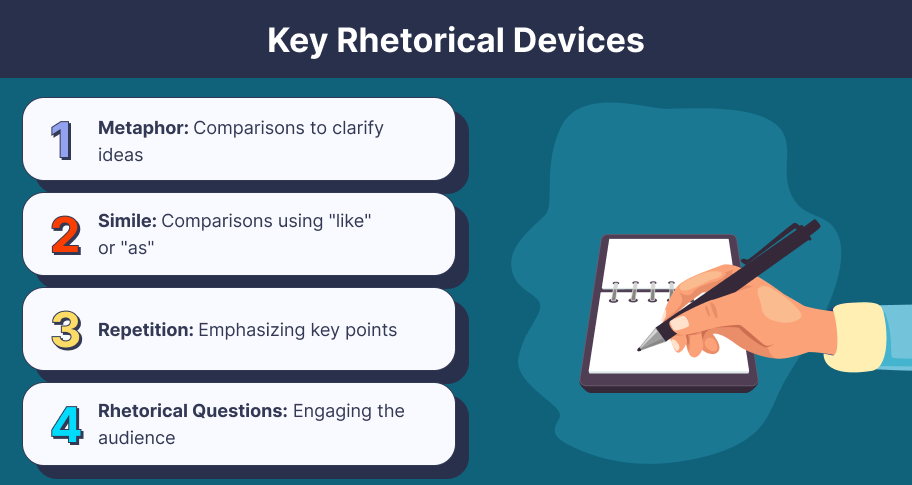
Steps to Writing a Rhetorical Analysis Essay
1. choose a suitable text.
Selecting a text rich in rhetorical devices is crucial when writing a rhetorical analysis essay. It offers substantial material for analysis, lets you highlight the author’s skill, provides clear examples of various rhetorical strategies, enhances critical thinking, engages the reader, and strengthens argumentation.
A text with numerous rhetorical devices offers a wealth of material for analysis. This variety allows for a more comprehensive examination of how different strategies contribute to the effectiveness of the text. It enables you to explore how various devices interplay to persuade or engage the audience.
Analyzing a text rich in rhetorical devices highlights the author’s skill in crafting their message. It provides insight into how deliberate choices in language and structure enhance the overall persuasive impact. This can reveal the author’s intent and the nuances of their argument.
A text rich in rhetorical devices allows you to clearly demonstrate how specific strategies—such as ethos, pathos, and logos—are employed. It shows how the author builds credibility, appeals to emotions, and uses logical arguments to persuade their audience.
With a variety of rhetorical devices, you can offer concrete examples to support your analysis. This strengthens your argument by showing how the author’s use of devices directly impacts the effectiveness of the text.
Analyzing a text with rich rhetorical devices challenges you to think critically about the author’s techniques. It encourages a deeper understanding of how language influences perception and how different strategies can be used to achieve specific effects.
A text with engaging rhetorical devices is more likely to captivate your interest and that of your readers. This engagement can make your analysis more compelling and insightful as you are more invested in examining how the text works.
When a text is rich in rhetorical devices, it provides multiple angles for discussing how the author’s choices contribute to their argument. This can help you build a more nuanced and robust analysis, making your essay more effective.
Selecting a text rich in rhetorical devices is essential for writing a thorough and insightful rhetorical analysis essay. It offers diverse examples and strategies to explore, enhances your ability to demonstrate how the text persuades its audience and enriches your analysis by revealing the intricacies of rhetorical craftsmanship.
Here are some examples of suitable texts for rhetorical analysis essays across various genres:
- “I Have a Dream” by Martin Luther King Jr. : A powerful speech addressing racial injustice and promoting equality, rich in rhetorical devices like metaphors, repetition, and pathos.
- “The Gettysburg Address” by Abraham Lincoln : Known for its use of ethos, logos, and pathos to unify and inspire a nation during the Civil War.
Advertisements
- Apple’s “Think Different” Campaign : Features persuasive techniques such as ethos and pathos to position Apple as innovative and revolutionary.
- Nike’s “Just Do It” Campaign : Uses ethos and pathos to create a motivational and empowering brand image.
- “Letter from Birmingham Jail” by Martin Luther King Jr. : A compelling essay that uses logos, ethos, and pathos to argue against racial segregation and injustice.
- “A Modest Proposal” by Jonathan Swift employs satire and irony to critique British policy towards the Irish, which is rich in rhetorical devices.
- Op-eds from The New York Times or The Guardian : These pieces often use rhetorical strategies to argue for or against specific policies or issues, providing ample material for analysis.
- “The Case for Reparations” by Ta-Nehisi Coates : Uses historical examples and emotional appeals to argue for reparations for African Americans.
Political Cartoons
- Political cartoons by artists like Gary Trudeau or Thomas Nast : Utilize visual rhetoric and satire to comment on political and social issues.
Literary Works
- “The Great Gatsby” by F. Scott Fitzgerald : Rich in metaphor, symbolism, and rhetorical style, particularly in the character of Gatsby and the narrative’s social commentary.
- “Pride and Prejudice” by Jane Austen Offers examples of irony and social critique through its characters and plot.
Media Clips
- TED Talks : Various TED Talks feature robust rhetorical strategies in addressing diverse topics, such as Simon Sinek’s “How Great Leaders Inspire Action.”
- Political Campaign Ads : Political campaign ads often use rhetoric to persuade voters, making them suitable for analysis.
Public Service Announcements (PSAs)
- “This Is Your Brain on Drugs” Campaign : Uses emotional appeals and stark imagery to discourage drug use.
- “Dove Real Beauty” Campaign : Employs pathos and ethos to promote body positivity and self-esteem.
These texts are ideal for rhetorical analysis as they provide rich examples of how language, imagery, and structure can be used to persuade, inform, or entertain. They each offer different angles for examining rhetorical strategies and their effectiveness.
2. Carefully Read and Analyze the Text
- Active Reading
It is essential to start with active reading. While reading the text, you want to be able to answer the following questions:
- What is the author’s main argument or message?
- Who is the intended audience?
- What rhetorical appeals are used?
- What rhetorical devices are employed?
- How effective is the author’s use of rhetoric?
You can use active reading to answer those questions. Active reading is an engaged and purposeful approach to reading that involves interacting with the text to enhance understanding and retention. Unlike passive reading, where one merely reads through the material, active reading requires the reader to engage with the content actively.
Skim the headings, subheadings, and introductory paragraphs to get an overview of the main ideas and structure. This will help you identify key terms and concepts that might be important.
Ask questions about the text before, during, and after reading to clarify understanding and maintain focus. Formulate questions such as “What is the author’s purpose?” or “What evidence supports this argument?”
Annotate in order to answer those questions. Highlight or underline important points and key details. Make notes in the margins to summarize information, jot down questions, or highlight significant points. After you finish a section, summarize it—paraphrase sections of the text in your own words to ensure comprehension. Write summaries of paragraphs or sections to capture the main ideas.
Once you have finished reading, think critically about the text’s arguments, biases, and implications. Consider the author’s purpose and whether the evidence supports their claims. Was the author effective at accomplishing their goals?
Active reading is particularly useful for academic study, professional development, and any context where deep comprehension and critical analysis are essential.
3. Develop a Strong Thesis Statement
A thesis statement is a concise summary of the main point or claim of a paper. It is typically one to two sentences long and clearly articulates the central argument or interpretation that the writer intends to support throughout the essay. In a rhetorical analysis essay, the thesis statement plays a crucial role in guiding the direction and focus of the analysis.
The rhetorical analysis essay thesis statement outlines the specific rhetorical strategies or elements of the text that will be analyzed. For example, it might focus on how the author uses ethos, pathos, and logos to persuade the audience.
It also guides the argument and sets the direction. It presents the central argument or interpretation regarding how effectively the author uses rhetorical techniques to achieve their purpose. The thesis statement helps organize the analysis by indicating which aspects of the rhetorical situation (such as the speaker’s credibility, emotional appeals, or logical arguments) will be examined.
The thesis provides a roadmap to your essay and frames the discussion. It often hints at the main points or sections of the essay, guiding readers on what to expect in the analysis. For instance, a thesis might indicate that the essay will explore how the speaker’s credibility (ethos), emotional appeals (pathos), and logical arguments (logos) contribute to the overall persuasiveness of the text. It serves as the foundation for the analysis, helping to ensure that each section of the essay supports and develops the central argument or claim made in the thesis.
Your thesis statement also needs to engage the reader so that they keep reading. A strong thesis statement presents a clear and intriguing argument that captures the reader’s attention and encourages them to read further.
Looking at an example of a thesis statement of a rhetorical analysis essay, we can break down its elements:
“In his speech, Martin Luther King Jr. effectively uses emotional appeals (pathos), ethical arguments (ethos), and logical reasoning (logos) to persuade his audience of the necessity of civil rights reform, demonstrating how a powerful rhetorical strategy can mobilize public support and drive social change.”
In this example, the thesis specifies that the essay will analyze how King uses emotional appeals, credibility, and logical arguments. It outlines the main areas of focus for the analysis. It provides a preview of what the reader can expect in the essay.
Overall, the thesis statement is a critical component of a rhetorical analysis essay. It provides a clear and focused argument that guides the analysis of how the author’s rhetorical choices influence their audience.
“In Apple’s ‘Think Different’ advertising campaign, the use of minimalist design and inspirational messaging (ethos and pathos) combined with the logical positioning of Apple as a symbol of innovation (logos) effectively rebrands the company as a leader in creativity and individuality, showcasing how branding strategies can influence consumer perception and loyalty.”
This thesis examines the use of design and messaging in advertising, focusing on how these elements create credibility, evoke emotions, and present logical arguments to enhance brand identity.
“In his editorial ‘The Case for Climate Action,’ Bill McKibben utilizes compelling statistics and scientific evidence (logos), personal anecdotes about environmental impact (pathos), and his established expertise in environmental issues (ethos) to persuade readers of the urgent need for climate change intervention, illustrating the power of combining empirical data with emotional and ethical appeals to drive public action.”
The thesis statement addresses McKibben’s use of data, personal stories, and credibility, aiming to analyze how these rhetorical strategies contribute to his persuasive argument about climate action.
4. Create a Detailed Outline
Organization is crucial in a rhetorical analysis essay outline because it ensures a clear, logical, and coherent presentation of your analysis. Effective organization matters. A well-organized essay outline helps you present your thesis and main points clearly, guiding readers through your analysis. It ensures that each part of your essay builds upon the previous one, reinforcing your argument.
Organizing your essay into distinct sections—such as introduction, analysis of rhetorical strategies, and conclusion—helps maintain a logical flow. It allows you to systematically examine how the author’s rhetorical choices contribute to their argument or purpose. An outline helps you stay focused on the specific rhetorical devices and strategies you plan to analyze. By breaking down your essay into sections, you can ensure that each rhetorical element is addressed in detail without deviating from your main argument.
With a structured outline, you can write more efficiently, as you have a clear roadmap to follow. It reduces the likelihood of writer’s block and helps you organize your thoughts before drafting. A well-organized outline contributes to the overall coherence and unity of your essay. It ensures that your analysis is consistent and that all points are relevant to your thesis, creating a more persuasive and compelling argument.
Finally, an outline allows for easier revision, as you can adjust the structure and flow of your argument before committing to the entire draft. This makes it simpler to identify and address any gaps or weaknesses in your analysis.
Effective organization in an outline is essential for crafting a clear, logical, and focused rhetorical analysis essay. It ensures that your argument is presented coherently and that each part of your analysis contributes to your overall thesis.
Here’s a sample outline form for a rhetorical analysis essay, which you can adapt to fit the specific text and rhetorical strategies you’re analyzing:
I. Introduction
A. Hook : Engage the reader with an exciting opening statement related to the text or its rhetorical elements.
B. Background Information : Provide brief context about the text, including its author, title, and purpose.
C. Thesis Statement : State the central argument of your analysis, outlining how the author’s rhetorical strategies achieve their purpose.
II. Summary of the Text
A. Overview : Summarize the main points or arguments of the text.
B. Purpose : Describe the primary goal or purpose of the text.
III. Analysis of Rhetorical Strategies
A. Ethos (Credibility)
1. Explanation : Define how the author establishes credibility or authority.
2. Evidence : Provide examples from the text that demonstrate the use of ethos.
3. Analysis : Discuss the effectiveness of these strategies in persuading the audience.
B. Pathos (Emotional Appeal)
1. Explanation : Define how the author appeals to the emotions of the audience.
2. Evidence : Provide examples from the text that demonstrate the use of pathos.
3. Analysis : Discuss the impact of these emotional appeals on the audience’s response.
C. Logos (Logical Appeal)
1. Explanation : Define how the author uses logic and reasoning to persuade the audience.
2. Evidence : Provide examples from the text that demonstrate the use of logos.
3. Analysis : Evaluate the effectiveness of these logical arguments in supporting the author’s purpose.
D. Additional Rhetorical Devices
1. Device 1 (e.g., Metaphor) – Explanation : Define the rhetorical device. – Evidence : Provide examples from the text. – Analysis : Assess the role and effectiveness of the device in the text.
2. Device 2 (e.g., Repetition) – Explanation : Define the rhetorical device. – Evidence : Provide examples from the text. – Analysis : Evaluate the impact of this device on the overall argument.
IV. Evaluation of Overall Effectiveness
A. Integration of Strategies : Discuss how the author’s use of ethos, pathos, logos, and other rhetorical devices work together to achieve their purpose.
B. Audience Impact : Analyze how these strategies affect the intended audience and contribute to the text’s overall effectiveness.
V. Conclusion
A. Restate Thesis : Summarize how the rhetorical strategies analyzed support the thesis.
B. Summary of Main Points : Recap the key findings from your analysis.
C. Significance : Discuss the importance of understanding these rhetorical strategies in the context of the text and its broader implications.
This outline provides a structured approach to analyzing the rhetorical elements of a text, ensuring that your essay is clear, focused, and well-organized. Adjust the sections as needed based on the specific text and your analysis.
5. Write the Essay
Writing a rhetorical analysis essay introduction involves setting up the context for your analysis, introducing the text, and presenting your thesis statement. Here’s a step-by-step guide on how to craft a practical introduction. Start with a hook to capture the reader’s interest and set the stage for your analysis. Provide context by giving the reader background information on the text you will analyze. Include the full title of the text. Mention the author’s name and any relevant background that enhances understanding. Briefly note when and where the text was published, if relevant. Explain the circumstances under which the text was created (e.g., historical context, intended audience).
You want to summarize the text. Remember, a summary is a concise overview of the main argument or message of the text. Highlight the key arguments or themes of the text and describe what the author aims to achieve with the text (e.g., to persuade, inform, entertain). You do not need to go into detail in the summary because you will go into detail in the body of your essay.
Your summary needs to introduce the rhetorical analysis. Then, it leads to the specific aspects of the text that will be analyzed. Mention the main rhetorical strategies or devices that will be discussed (e.g., ethos, pathos, logos). The essay will analyze how these strategies contribute to the text’s effectiveness.
Finally, present your thesis statement. This should be the last sentence of two of your introduction. Clearly state the central argument of your essay. Summarize how the rhetorical strategies are used to achieve the author’s purpose. Briefly mention the critical points of your analysis (e.g., how ethos, pathos, and logos are employed).
Body Paragraphs
In a standard five-paragraph essay, you will have three body paragraphs. Each of those paragraphs should focus on one of the three points in the triangle—ethos, pathos, and logos. It does not matter which order you address them, but you need to address all three of them.
One body paragraph should focus on ethos or credibility. Define how the author establishes credibility or authority. Provide examples from the text that demonstrate the use of ethos. Discuss the effectiveness of these strategies in persuading the audience.
One body paragraph should focus on pathos or emotional appeal. Define how the author appeals to the emotions of the audience. Provide examples from the text that demonstrate the use of pathos. Discuss the impact of these emotional appeals on the audience’s response.
One body paragraph should focus on logos or logical appeal. Define how the author uses logic and reasoning to persuade the audience. Provide examples from the text that demonstrate the use of logos. Evaluate the effectiveness of these logical arguments in supporting the author’s purpose.
Writing a rhetorical analysis essay conclusion involves summarizing your analysis, reflecting on its significance, and reinforcing your thesis. Start with restating your thesis. Remind the reader of your main argument and how the rhetorical strategies support it. Paraphrase your thesis statement, summarizing the key points of your analysis.
Next, summarize the key points of the essay. Briefly review the main rhetorical strategies and their effects, reinforcing how they contribute to the effectiveness of the text. Highlight the significant rhetorical devices and strategies discussed in your essay and how they functioned to achieve the author’s purpose.
It is not enough to summarize; you also need to reflect on the significance of those points. Explain the broader implications of your analysis and the text’s impact on its audience. Discuss how the rhetorical strategies enhanced or diminished the overall effectiveness of the text. Reflect on how the text’s rhetorical choices affected its intended audience or contributed to its persuasive power.
Ideally, you want to use your conclusion to go beyond the text of your essay. Connect your analysis to more prominent themes or contemporary relevance. Discuss how the rhetorical strategies used in the text can be applied to other contexts or texts. If relevant, mention how understanding these strategies can be helpful in today’s media and communication landscape.
Finally, you want to close with a solid final thought. Leave the reader with a memorable insight or reflection related to the text and your analysis. Offer a final observation that ties back to your analysis. Encourage further thought or action based on the insights from your essay.
Revise and Edit
Proofreading and revising are crucial steps in the writing process because they ensure that your work is clear, accurate, and effective.
Proofreading helps identify and correct typographical, grammatical, and spelling errors that could undermine your credibility or confuse your readers. It ensures consistency in style, formatting, and terminology throughout the document, which is essential for professionalism and readability. By reviewing your work, you can spot and fix awkward phrasing or unclear sentences, improving overall clarity and comprehension.
There is no reason you should ever turn in a document with clarity, grammar, or punctuation errors. You can use tools online to check for these errors, and turning in an unchecked paper looks lazy.
Revising allows you to refine your arguments, enhance your ideas, and ensure that your writing effectively communicates your intended message. It helps you to structure your content logically and coherently. It gives you the opportunity to incorporate feedback from others, whether they are peers, editors, or instructors, leading to a more polished and persuasive piece. Revising provides the chance to add depth to your analysis or argument, strengthen your evidence, and ensure that all aspects of the assignment are fully addressed.
Overall, both proofreading and revising contribute to producing a high-quality, effective piece of writing that meets its purpose and engages its audience.
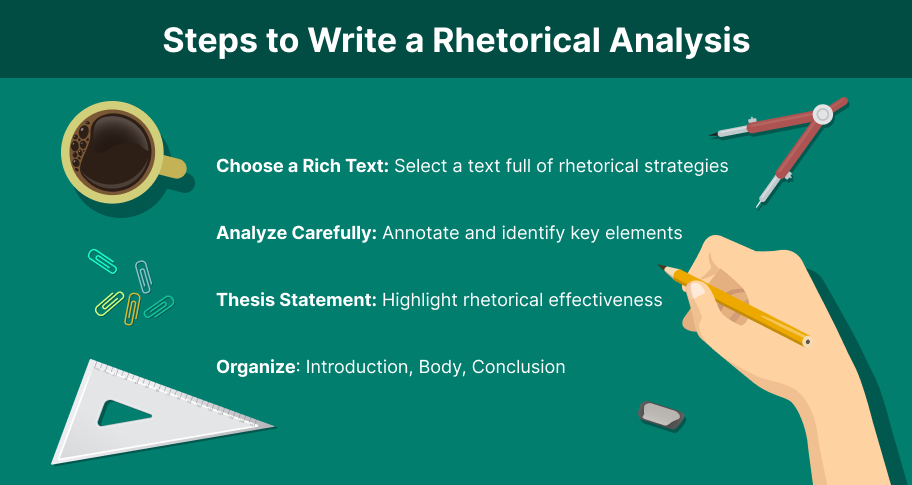
Rhetorical Analysis Essay Example
Title: The Persuasive Power of Martin Luther King Jr.’s “I Have a Dream” Speech
Introduction: Martin Luther King Jr.’s “I Have a Dream” speech, delivered during the 1963 March on Washington, is a seminal text in American history. King’s masterful use of rhetorical strategies has cemented this speech as a powerful tool in the civil rights movement. This essay analyzes how King employs ethos, pathos, and logos to persuade his audience of the necessity for racial equality and justice.
Ethos: King establishes credibility through his role as a prominent civil rights leader and his deep moral authority. His reputation and commitment to nonviolent protest lend weight to his message. By referencing the founding documents of the United States, King aligns himself with the nation’s values, enhancing his ethical appeal. His position as a minister also adds to his moral credibility, allowing him to speak with conviction and integrity.
Pathos: King effectively uses emotional appeals to connect with his audience. His vivid imagery and evocative language, such as “a dream deeply rooted in the American dream,” evoke strong feelings of hope and urgency. By sharing personal stories and invoking the suffering of African Americans, he generates empathy and mobilizes his audience to support the cause of racial justice.
Logos: King’s logical arguments are grounded in historical and legal references. He cites the Declaration of Independence and the Constitution to demonstrate that racial inequality is contrary to American principles. His structured arguments and clear examples of injustices provide a rational basis for his call for change, reinforcing his credibility and appealing to the audience’s sense of justice.
Conclusion: Martin Luther King Jr.’s “I Have a Dream” speech exemplifies the effective use of rhetorical strategies to inspire and persuade. Through his establishment of credibility, emotional appeals, and logical arguments, King crafts a compelling message that resonates with his audience and galvanizes support for the civil rights movement. His use of ethos, pathos, and logos ensures the speech’s enduring impact and relevance.
Analysis of Key Elements
- Establishment of Credibility: The essay highlights King’s role and reputation, showing how his credibility as a leader enhances his persuasive power.
- Moral Authority: Mentioning King’s background as a minister adds to his ethical appeal, making his arguments more persuasive.
- Emotional Appeals: The analysis identifies how King uses evocative language and imagery to stir emotions and build a connection with the audience.
- Personal Stories: By pointing out King’s use of personal and historical suffering, the essay demonstrates how pathos can engage the audience’s empathy and support.
- Logical Arguments: The essay notes King’s use of historical and legal references to build a rational case for civil rights.
- Structured Arguments: It highlights how clear, reasoned arguments support King’s call for change, appealing to the audience’s sense of justice and rationality.
4. Overall Analysis:
- Integration of Rhetorical Strategies: The essay effectively integrates the analysis of ethos, pathos, and logos, showing how each element contributes to the speech’s persuasive power.
- Impact and Relevance: By discussing the speech’s enduring impact, the analysis reinforces the effectiveness of King’s rhetorical strategies in achieving his goals.
This example illustrates how a rhetorical analysis essay can dissect a text’s components to understand and explain its effectiveness in persuasion.
Tips for Writing an Effective Rhetorical Analysis Essay
- Avoid summarizing the text; focus on analyzing its rhetorical elements.
- Use clear and concise language.
- Support your analysis with evidence from the text.
- Be objective and avoid personal bias.
- Proofread carefully before submitting.
In this article, we have covered the basics of rhetoric, covered the steps to writing a rhetorical essay, provided the form of an outline, provided an example essay, and provided tips to writers. However, nothing teaches someone how to analyze rhetoric like actually doing it. If you are working on rhetorical analysis, practice with different texts. You can find examples online or use our tools to see if your analysis matches what other readers and writers have noted.
Ready to start your essay? Download our Rhetorical Analysis Essay Worksheet for free.
If you found this article insightful and valuable, why not share it with your friends and followers on social media? Your support helps spread important information and spark meaningful discussions. We’d also love to hear from you! Leave a comment below or ask any questions you might have—we’re here to engage and provide answers. Let’s continue the conversation and connect with others who might benefit from this content!
Here are some resources that can help with writing rhetorical analysis essays:
“Everything’s an Argument” by Andrea A. Lunsford, John J. Ruszkiewicz, and Keith Walters
Offers an introduction to rhetorical analysis and the elements of effective argumentation.
“The Rhetorical Situation” by Lloyd Bitzer
Explores the concept of the rhetorical situation and its components.
“Rhetorical Analysis: A Brief Guide for Writers” by Philip K. Jason
Provides an overview of how to analyze rhetorical texts and write about them effectively.
Online Resources
Purdue OWL: Rhetorical Analysis
The Purdue Online Writing Lab offers comprehensive guidelines on writing rhetorical analysis essays, including strategies for analyzing texts and constructing arguments.
University of North Carolina at Chapel Hill Writing Center: Rhetorical Analysis
Provides practical advice on conducting a rhetorical analysis and includes examples and tips for structuring the essay.
Harvard College Writing Center: Rhetorical Strategies
This resource offers insights into different rhetorical strategies and how they can be used in analysis.
Academic Journals and Articles
“Rhetoric Review”
A journal that features scholarly articles on various aspects of rhetorical theory and practice, including rhetorical analysis.
“The Quarterly Journal of Speech”
Offers articles and research on rhetorical theory and practice, providing insights into rhetorical analysis techniques.
Google Scholar
Search for academic articles and papers on rhetorical analysis to find studies and examples relevant to writing your essays.
These resources should provide a solid foundation for understanding and writing rhetorical analysis essays, offering guidance on everything from basic concepts to advanced analytical techniques.
Take the first step to becoming a better academic writer.
Writing tools.
- How to write a research proposal 2021 guide
- Guide to citing in MLA
- Guide to citing in APA format
- Chicago style citation guide
- Harvard referencing and citing guide
- How to complete an informative essay outline

Unlock Your Writing Potential with Our AI Essay Writing Assistant

The Negative Impacts of Artificial Intelligence on Tactile Learning

Overcome Your Writer’s Block: Essay Writing Tips for Students

How to Write a Synthesis Essay: Tips and Techniques

IMAGES
VIDEO
COMMENTS
Download free-response questions from this year's exam and past exams along with scoring guidelines, sample responses from exam takers, and scoring distributions. If you are using assistive technology and need help accessing these PDFs in another format, contact Services for Students with Disabilities at 212-713-8333 or by email at ssd@info ...
AP® ENGLISH LANGUAGE AND COMPOSITION 2012 SCORING GUIDELINES Question 2 The score should reflect a judgment of the essay's quality as a whole. Remember that students had only ... This essay advances uneven evidence and explanations in supporting its analysis of Kennedy's rhetorical strategies. The first example uses a family metaphor ...
The AP Lang Rhetorical Analysis Essay is one of three essays included in the written portion of the AP English Exam. The full AP English Exam is 3 hours and 15 minutes long, with the first 60 minutes dedicated to multiple-choice questions. Once you complete the multiple-choice section, you move on to three equally weighted essays that ask you ...
Question 2. (Suggested time—40 minutes. This question counts for one-third of the total essay section score.) On April 10, 1962, as the United States was emerging from a recession, the nation's largest steel companies raised steel prices by 3.5 percent.
4. Be Sure to Explain Your Examples. As you write the essay, don't just list out your examples and say something like "this is an example of ethos, logos, pathos.". Instead, analyze how the example shows that rhetoric device and how it helps the author further their argument. As you write the rhetorical essay, you'll want to be as ...
AP English Language and Composition: Sample Argument Question. The following paragraph is adapted from Mirror for Man, a book written by anthropologist Clyde Kluckhorn in the middle of the twentieth century. Read the passage carefully. Then, write an essay that examines the extent to which the author's characterization of the United States ...
In this video, I'll show you how to write the AP English Language rhetorical analysis essay (Q2) step by step using the actual 2017 prompt. Watch me annotate...
The previously-released 2012 sample AP® English Language and Composition exam questions, sample responses, and grading rubrics are valuable learning tools. ... Together, they're a road map to a high score on the rhetorical analysis essay. Start with a Succinct Introduction that Includes Your Claim. All three essays present their claims in ...
AP English Language Scoring Rubric, Free-Response Question 1-3 | SG 1 Scoring Rubric for Question 1: Synthesis Essay 6 points Reporting Category Scoring Criteria Row A Thesis (0-1 points) 4.B 0 points For any of the following: • There is no defensible thesis. • The intended thesis only restates the prompt.
The rhetorical analysis essay in the AP Lang exam involves students having to discuss how the authors' contribution to the passage gives a theme or meaning. A synthesis essay involves students creating arguments on the passage or piece of information delivered to them. An argumentative essay requires students to pick a side 'for or against ...
Sample: 2A Score: 8. This essay effectively identifies and analyzes three of Cesar Chavez's rhetorical choices — striking diction, juxtaposition, and appeals to reader's fundamental moral beliefs — to argue that "nonviolence is the best and most moral way to bring change.". Providing convincing evidence and analysis (for example ...
AP English Language and Composition Rhetorical Analysis Free-Response Question (2020) Sample Student Responses 3 pathos and emotion, reminding the people of a common love for one's country and president, and an admiring tone towards Kennedy, he was able to secure the funds to support the library and museum in Kennedy's honor.
The AP Lang analysis essay, also known as the rhetorical analysis essay, requires you to analyze a text (usually a speech or an article) and explain how the author uses various rhetorical strategies to achieve their purpose. Here are the steps you should follow: 1. Read the prompt: Carefully read the given prompt, which will provide you with ...
3. The third sentence explains how the rhetorical strategies you discussed in the previous sentences help the writer achieve his purpose by using an in order to statement. He joins in this time of mourning in order to unify the nation and humbly admit that "we share this pain with all of the people of our country" (4).
Essays earning a score of 9 meet the criteria for a score of 8 and, in addition, are especially sophisticated in their argument, thorough in their development, or impressive in their control of language. 8 Effective . Essays earning a score of 8 . effectively. analyze . ∗. the rhetorical strategies President Kennedy uses to achieve his purpose.
AP English Language and Composition Rhetorical Analysis Free-Response Question (2020) Sample Student Responses 1 Sample A [1] To this very day, hate surrounds us. It was no different in the twentieth century, with segregation and rampant wars prevalent. Citizens of all nations were being left behind in rubble and
First sentence: Body paragraph. "At the beginning of title, author uses a rhetorical strategy 1 ". Second and third sentence: Body paragraph. "Consider how the inclusion of rhetorical strategy 1 builds author's argument . Explain how the rhetorical strategy helps to convey the writer's / speaker's overall claim or purpose .
rhetorical situation by doing any of the following: 1. Explaining the significance or relevance of the writer's rhetorical choices (given the rhetorical situation). 2. Explaining a purpose or function of the passage's complexities or tensions. 3. Employing a style that is consistently vivid and persuasive.
The question directed students to read carefully an excerpt of William Hazlitt's 1827 essay, "On the Want of Money," and to analyze the rhetorical strategies the author uses to develop his position about money. Sample: 2A Score: 8. This essay's control and focus are evident from the first sentence.
2. Language or dialect of a regional clan or group. 3. Plain everyday speech. Didactic - A term used to describe fiction, nonfiction or poetry that teaches a specific lesson or moral or provides a model of correct behavior or thinking. Adage - A folk saying with a lesson. "A rolling stone gathers no moss.".
AP ® English Language and Composition ... Rhetorical Analysis 6 points . On February 27, 2013, while in office, former president Barack Obama delivered the following address dedicating the Rosa Parks st atue in the National Statuary Hall of the United States Capitol building. Rosa Parks was an African American civil rights activist who was ...
A rhetorical analysis essay examines how an author or speaker uses language and rhetorical strategies to persuade their audience. The purpose of this type of essay is to analyze the effectiveness of these techniques in achieving the author's goals. ... Tips for Writing an Effective Rhetorical Analysis Essay. Avoid summarizing the text; focus ...
The essay's score should reflect an evaluation of the essay as a whole. Students had only 40 minutes to read and write; the essay, therefore, is not a finished product and should not be judged according to standards appropriate for an out-of-class assignment. The essay should be evaluated as a draft, and students should be rewarded for what ...
Gandhi balances fear of losing a resource and thoughts of gaining an ally. AP English Language and Composition Question 2: Rhetorical Analysis (2019) Sample Student Responses. 7. in his letter. Fear of one and hope for another, better, relationship was Gandhi's goal to convince Lord Irwin to end the Salt Law.